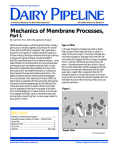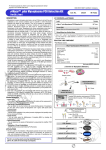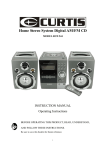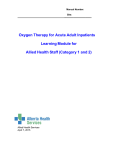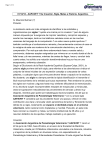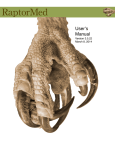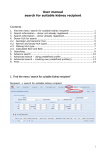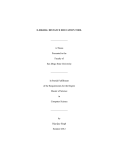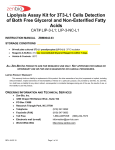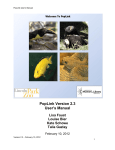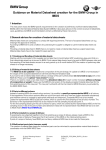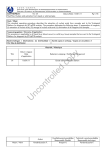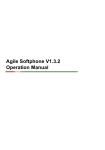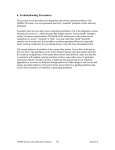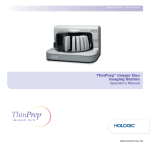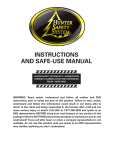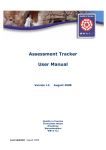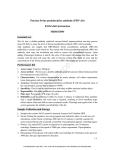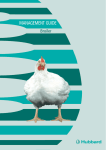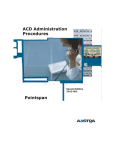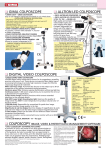Download User Guide - South Dakota State University
Transcript
South Dakota State University Animal Disease Research & Diagnostic Laboratory User’s Guide (Last Updated 6.22.12) SDSU-ADRDL Department of Veterinary Science Box 2175, North Campus Drive South Dakota State University Brookings, South Dakota 57007-1396 The materials in this handbook have been prepared by faculty and staff of the Animal Disease Research and Diagnostic Laboratory, South Dakota State University. Inquiries regarding the handbook and its content should be made to: David H. Zeman DVM, PhD Head, Veterinary & Biomedical Sciences Dept. & Director, ADRDL & OBL OR Tanya D. Graham, DVM, DACVP Associate Director—ADRDL c/o South Dakota State University North Campus Drive—Box 2175 Brookings, SD 57007-1396 Phone: 605.688.5171 Fax: 605.688.6003 TABLE OF CONTENTS CLICK ON THE LINKS BELOW TO GO TO THAT PAGE. GENERAL INFORMATION Page 6 SERVICES & MISSION QUALITY PROGRAM & CUSTOMER SERVICE COMPUTER-BASED CASE REPORTING (VADDS) Page 7 CONTACT INFORMATION Page 8 MAILING / SHIPPING ADDRESS FACULTY CONTACTS WEB PAGE LOCATION & SUBMISSION INFORMATION Page 9 LABORATORY POLICIES Page 10 RECEIVING & BUSINESS HOURS SUBMISSION FORMS VETERINARY REFERAL & REPORTING LIVE ANIMAL SUBMISSION CARCASS DISPOSITION REPORTABLE DISEASES DIAGNOSTIC TESTING Page 11 STANDARD DIAGNOSTIC EVALUATION TEST SET-UP SCHEDULE SPECIFIC SYNDROMES ARTHRITIS AVIAN INFLUENZA CHRONIC WASTING DISEASE ENTERITIS NEUROLOGIC DISORDERS (EXCLUDING RABIES) PNEUMONIA / RESPIRATORY DISEASE RABIES HOW TO SUBMIT RABIES-SUSPECT CASES TO ADRDL FEE POLICY RESULTS AND REPORTING SUBMITTING RABIES CASES TO SOUTH DAKOTA PUBLIC HEALTH LAB SCRAPIE TRICHOMONIASIS PATHOLOGY BIOPSY SERVICE EXCISIONAL BIOPSIES ASPIRATES & IMPRESSIONS FIXATION WITH NEUTRAL BUFFERED FORMALIN Page 12 Page 12 Page 13 Page 14 Page 15 Page 16 Page 18 Page 19 Page 21 Page 22 Page 23 Page 25 Page 26 Page 27 Page 28 ROUTINE HISTOPATHOLOGY IMMUNOHISTOCHEMISTRY BVD EAR NOTCH TEST OTHER TESTS AVAILABLE Page 30 BACTERIOLOGY & MYCOLOGY GENERAL GUIDELINES ANTIBIOTIC SENSITIVITY TESTING SPECIFIC SYNDROMES Page 31 Page 32 SEROLOGY GENERAL SAMPLING PROCEDURES BOVINE SEROLOGIC TESTS SCHEDULE FOR BOVINE SEROLOGIC TESTS CAPRINE SEROLOGIC TESTS & SCHEDULE EQUINE SEROLOGIC TESTS & SCHEDULE OVINE SEROLOGIC TESTS SCHEDULE FOR OVINE SEROLOGIC TESTS PORCINE SEROLOGIC TESTS SCHEDULE FOR PORCINE SEROLOGIC TESTS SMALL ANIMAL SEROLOGIC TESTS SCHEDULE FOR SMALL ANIMAL SEROLOGIC TESTS ABBREVIATIONS INTERPRETATION OF SEROLOGIC TEST RESULTS Page 34 Page 35 Page 36 Page 37 Page 38 Page 39 Page 40 Page 42 VIROLOGY GENERAL GUIDELINES SAMPLING & SUBMISSION GUIDELINES AGENTS DETECTABLE BY ISOLATION* FLUORESCENT ANTIBODY TESTS AVAILABLE* Page 43 Page 44 MOLECULAR DIAGNOSTICS (PCR) AVIAN INFLUENZA (SCREENING) BOVINE LEUKOSIS VIRUS BVD CIRCOVIRUS (PORCINE) TYPE 2 CLOSTRIDIUM PERFRINGENS GENOTYPING E. COLI GENOTYPING JOHNES’ DISEASE LAWSONIA INTRACELLULARIS MYCOPLASMA BOVIS MYCOPLASMA HYOPNEUMONIAE PRRSV NORTH AMERICAN/EUROPEAN/EUROPEAN-LIKE PRRSV— SCREENING ASSAY QUANTITATIVE ASSAY Page 4 Page 45 TRITRICHOMONAS FOETUS SEQUENCING SERVICES AVAILABLE DNA SEQUENCING Page 46 Page 47 CLINICAL PATHOLOGY HEMATOLOGY COMPLETE BLOOD COUNT BLOOD TYPING COOMB’S TEST URINE / FLUIDS / CYTOLOGY SERUM CHEMISTRY CUSTOM PROFILES SPECIAL CHEMISTRY AND IMMUNOLOGY ASSAYS PARASITOLOGY AND FECAL ELISA TESTING SAMPLE SUBMISSION TEST INTERPRETATION LABORATORY NORMAL RANGES FOR CLINICAL CHEMISTRY TRACE MINERALS Page 49 Page 50 Page 52 Page 53 Page 55 Page 57 Page 58 TOXICOLOGY GENERAL INFORMATION SAMPLES GENERALLY REQUIRED (WHAT AND HOW MUCH) WATER ANALYSIS SAMPLES REQUIRED FOR SPECIFIC TOXINS TRACE MINERALS FEED ANALYSIS Page 59 Page 62 Page 62 FOOD SAFETY MICROBIOLOGY MEAT INSPECTION PROGRAM TESTING FOOD SAFETY INDUSTRY TESTING Page 64 Page 65 APPENDICES CURRENT FEE SCHEDULE QUALITY MANUAL SUBMISSION FORMS Page 5 GENERAL INFORMATION SERVICES & MISSION The mission of the SDSU ADRDL is to provide high quality veterinary diagnostic services as a means to promptly and accurately establish causes of animal health problems. Such diagnoses will aid attending veterinarians and health officials in the treatment, control, prevention and surveillance of animal diseases to the benefit of the livestock industry, other animal owners, and society at large. We also continually look for research opportunities utilizing the case materials. The ADRDL is an accredited AAVLD laboratory and a member of the USDA National Animal Health Network. Completing and submitting any submission form or any other means of requesting services creates a contractual agreement for services requested and the specimens submitted become the property of the ADRDL. In addition, at no additional expense to our clients, specimens submitted to the ADRDL may be subjected to additional testing upon the order of state or federal animal health officials, or whenever a Foreign Animal Disease is suspected, or in support of surveillance for other animal diseases. We take pleasure in serving our clients and improving animal health. We look forward to your submissions. QUALITY PROGRAM & CUSTOMER SERVICE ADRDL maintains a Quality System compliant to the American Association of Veterinary Laboratory Diagnosticians (AAVLD) standards. The AAVLD accreditation program is based on the OIE guidelines. The accreditation process helps us demonstrate and prove our abilities to provide quality diagnostic services to the animal owners of South Dakota and surrounding areas. Our quality system has a simple rule: “SAY WHAT YOU DO. DO WHAT YOU SAY. PROVE IT”. Through this rule, we strive to make sure that the quality system policies and procedures established as per AAVLD standards are followed from the time we receive samples to reporting results to the clients as rapidly as we can. Page 6 COMPUTER-BASED CASE REPORTING (VADDS) The Animal Disease Research and Diagnostic Laboratory, SDSU, Brookings South Dakota offers access to your verified laboratory results through the World Wide Web. Our Internet address is: http://www.sdstate.edu/vs/ To obtain your veterinary clinic’s personalized security code and password, please complete the form below and return it by mail to the address below or fax the completed form to: (605) 688-6003. ADRDL-SDSU Box 2175, North Campus Drive Brookings, SD 57007-1396 VETERINARY CLINIC NAME: VETERINARIANS CURRENTLY AT THE CLINIC: ADDRESS: CITY: STATE PHONE FAX ZIP CODE VETERINARY CLINIC’S AUTHORIZATION SIGNATURE: If a password change is required at a later date, please contact our office: 5171 or (605) 688-6003 (fax) ADRDL Office Use Only User Code: ___________________________ Password: ___________________________ Effective: _______/_________/__________ Page 7 (605) 688- CONTACT INFORMATION MAILING / SHIPPING ADDRESS Animal Disease Research and Diagnostic Laboratory Department of Veterinary Science North Campus Drive—Box 2175 South Dakota State University Brookings, SD 57007-1396 605.688.5171 (Main Office) 605.688.6003 (Fax) FACULTY CONTACTS http://www.sdstate.edu/vs/faculty/index.cfm WEB PAGE http://www.sdstate.edu/vs/ Page 8 LOCATION & SUBMISSION INFORMATION From Interstate 29, take Exit 133. Turn west onto Highway 14 Bypass and travel to first stoplight. Turn south onto Medary Ave. At the first opportunity get into the left-hand turn lane and turn left (east) onto North Campus Drive. ADRDL is the second building in the left (north side of the road). Look for the diagnostic lab receiving sign on the east side of the building. Submissions are received from 8:00-12:00 noon and from 1:00-5:00 p.m., Monday through Friday, with the exception of state and federal holidays. Emergency diagnostic services may be arranged on evenings, weekends, and holidays for bona fide emergencies. This should be pre-arranged by contacting the lab before closing or after hours by contacting the on-call diagnostician at 605.690.1576. The emergency service is not provided for delivery convenience or procrastination. For customer convenience, necropsy samples, serum, and small dead animals can be left in the ADRDL cooler 24 hours/day, 7 days/week. It is the responsibility of the client to adequately identify such samples and leave a completed submission form. (Tags and submission forms are located in a mailbox just outside the necropsy cooler. Mail is picked up on Saturday and placed in the cooler for processing on Monday. Mailed specimens should be sent through the fastest practical carrier. Mailed submissions should be timed to avoid weekend and holiday delivery delays whenever possible. A completed submission form must accompany all submissions. The submission form is intentionally designed to be short and concise. The information requested is necessary to focus the examination and thereby limit the time and cost of laboratory testing. A minimal amount of information is requested for epidemiological purposes. Your cooperation in filling out the submission form as completely as possible is greatly appreciated and will enhance the quality of our diagnostic investigation. Page 9 LABORATORY POLICIES RECEIVING & BUSINESS HOURS Monday-Friday 8:00 a.m.-5:00 p.m. (Except on Holidays). After hours emergencies are referred to a veterinarian on call at 605.690.1576 SUBMISSION FORMS Submission forms can be downloaded at http://www.sdstate.edu/vs/adrdl/forms/index.cfm. VETERINARY REFERAL & REPORTING • Mammalian cases should be submitted by or on referral from a licensed veterinarian. • Poultry are accepted from flock owners or poultry servicemen. • Rabies specimens are accepted from veterinarians, physicians, and public health officials. • State and federal wildlife personnel may submit wildlife. Final signed reports and invoices will be mailed to the submitting veterinarian and can be sent to the owner upon the request of the owner or the submitting veterinarian. It is the responsibility of the veterinarian to report the laboratory results to the owner. In addition, if veterinarians would like to receive the final results by e-mail and/or fax, please contact us at 605-688-5171 to personalize your account. Password protected preliminary and final case results are available to the veterinarian via the Internet (refer to the VADDS REPORT GENERATOR at http://www.sdstate.edu/vs). LIVE ANIMAL SUBMISSION Do not bring animals into the receiving office. During regular business hours please come into the receiving office so that we may complete a submission form and help you to unload your animal(s). Large animals (live and dead) may be unloaded at the receiving dock (east side of the ADRDL) during regular business hours. For customer convenience, necropsy samples, serum, and small dead animals can be left in the ADRDL cooler 24 hours/day, 7 days/week. It is the responsibility of the client to adequately identify such samples and leave a completed submission form. (Tags and submission forms are located in a mailbox just outside the necropsy cooler.) On the weekends / after regular business hours you will need to contact the veterinarian on call at 605.690.1576 to have large animals unloaded. CARCASS DISPOSITION Carcasses become the property of the ADRDL and cannot be returned to the submitter. Carcasses are incinerated or rendered, according to local, state, and federal regulations regarding carcass disposition. REPORTABLE DISEASES The Animal Industry Board is required by state law to establish a list of reportable and quarantinable diseases each year on July 1. Reports of such diseases must be made immediately by telephone, fax, or writing by licensed accredited veterinarians and by all diagnostic laboratories who diagnose diseases on this list. Copies of this list shall be mailed to Page 10 all licensed and accredited veterinarians and to diagnostic laboratories on July 1 of each year and are available at no charge from the South Dakota Animal Industry Board, 411 South Fort Street, Pierre, South Dakota 57501. The board may keep such reports confidential, except for those reports concerning diseases that are specifically regulated for mandatory control and eradication to protect the public health, other livestock, or wildlife. Source: 27 SDR 96, effective April 1, 2001. General Authority: SDCL 40-3-14, 40-5-7, 40-5-8.6. Law Implemented: SDCL 40-57. DIAGNOSTIC TESTING STANDARD DIAGNOSTIC EVALUATION Specimens are processed on the day they are received with very few exceptions. The time frame for processing specimens and receiving results in the laboratory is as follows: Tissues sent by mail, UPS, or bus are usually received in 1-2 days FAT results are completed on the day of receipt or the following morning Bacterial isolation requires 1-2 days excluding contamination o Sensitivity testing takes another day. o Enrichment cultures for Salmonella require an extra day o Campylobacter cultures require 3-5 days Tissues for microscopic examination are trimmed on the day following receipt and are returned to the pathologists on the afternoon of the third working day One or two days are required to read the slides and dictate the letters o It takes 1-2 days to deliver mailed reports to the submitting veterinarian Some serology tests are not set up daily because of the small number of samples or because of the time requirements of some tests—please refer to the serology schedule for additional information. TEST SET-UP SCHEDULE For specific information about how often tests are set up and expected turn-around times, click on the TEST SET-UP SCHEDULE tab at: http://www.sdstate.edu/vs/adrdl/index.cfm Page 11 SPECIFIC SYNDROMES ARTHRITIS SPECIMENS TO SUBMIT ANTEMORTEM Joint fluid - Use aseptic technique, a sterile needle, and syringe to draw joint fluid. POSTMORTEM Entire joint - The limb may be severed above and below the affected joint and the entire joint submitted. Put entire joints into plastic bags and seal. Joint fluid - Use aseptic technique, a sterile needle, and syringe to draw joint fluid or use aseptic technique to open the joint with a sterile blade. Use a sterile swab to reach deep into the joint cavity. Put containers of joint fluid and joint swabs into plastic bags and seal. Ship in an insulated container with enough ice packs to maintain refrigeration until the specimens arrive at the laboratory. NOTE: Mycoplasmas and Ureaplasmas do not survive on cotton swabs. Dacron swabs with special transport media are required. Contact the laboratory if help is needed. Diagnosis of CAE in adult goats is by clinical sign, joint capsule lesions (macro- and microscopic), elimination of other causes, and positive AGID serology results (evidence of exposure). DETECTABLE AGENTS - Bacteria (common aerobic & anaerobic bacteria), Chlamydia and Erysipelothrix, Mycoplasma, Viruses Page 12 AVIAN INFLUENZA Negative AGID SEROLOGY (AGID—Identifies Type A Influenza Virus) Positive Matrix Type A No further testing is required Send serum to NVSL for typing and/or submit swabs for PCR Sensitivity of the AGID test: Not published. Turn-around-time: TAT for serology testing is generally 2 to 3 business days. PCR / SWAB TEST (required for ducks and geese)—Oropharyngeal &/or Cloacal Swabs Negative Matrix Type A Positive Matrix Type A No further testing is required ADRDL runs H5 & H7 PCR tests; if H5 or H7 PCR is positive: Sample(s) are sent to NVSL for confirmation and to ID the type of AI virus Page 13 CHRONIC WASTING DISEASE SPECIMENS TO SUBMIT Fresh unfixed retropharyngeal lymph node. For details about how to collect the retropharyngeal lymph node see http://agbiopubs.sdstate.edu/articles/ExEx11012.pdf. Formalin-fixed obex. A pictorial obex removal is available at http://www.aphis.usda.gov/vs/nvsl/BSE/procedure_manual.pdf The following instructions on obex removal using the scoop method is from Bio-Rad’s Brain Stem Sampling Procedure in the Slaughterhouse With the head placed flat on the table, resting on the forehead and nose. The spoon can be easily inserted thru the foramen magnum, underneath the dura mater, with the convexity of the spoon facing downwards. By advancing anteriorly in the axis of the medulla oblongata, the anterior lip of the spoon sections the base of the cerebellum, isolating the cerebellar peduncles (anterior, middle, and posterior). The roots of the cranial nerves are sectioned by rotating the spoon from left to right and from right to left. If you have trouble severing the cranial nerves, hold the dura covering the brain stem with forceps and slide curved scissors into the foramen magnum to cut the cranial nerves. Once you are comfortable using the spoon technique you may not need to use the scissors to section the cranial nerves. Page 14 ENTERITIS SPECIMENS TO SUBMIT—ALL SPECIES, PER ANIMAL Duodenum • One 6–inch length, fresh • One 2 inch-length fixed in 10% buffered formalin Jejunum & Ileum • Two 6–inch lengths each, fresh • Two 2 inch-lengths each fixed in 10% buffered formalin Cecum & Spiral Colon • Two 2-inch squares each or several partial loops (piglet), fresh • Two 2-inch squares each, fixed in 10% buffered formalin Colon or Cecal Content (fresh) • 2-5 ml in plastic bag or tube Mesenteric lymph nodes (one each from mid and lower gut), fresh FOR OPTIMAL ENTERITIS DIAGNOSTIC SUCCESS - Samples must be taken as soon after death as possible. Do not open or tie-off intestinal tissue that you are submitting to the lab. Do not freeze. Pool all formalin-fixed tissues in one container with adequate amounts of formalin. For fresh tissue, package and label the small intestine separately from the cecum/colon. No not mix intestinal samples with other viscera. Chill fresh intestine and colon content before mailing. Pack in an insulated diagnostic shipping container with enough ice packs to maintain refrigeration until the specimens reach the laboratory. Page 15 NEUROLOGIC DISORDERS (EXCLUDING RABIES) Many toxic, nutritional and metabolic causes of CNS disease do not produce lesions in the brain and require analysis of other tissues/samples for definitive diagnosis; submission of whole blood (EDTA), rumen contents, feed sample(s), water sample(s), liver, kidney and brain may aid in diagnosis of many of these causes. ROUTINE SPECIMENS FOR SUBMISSION** **NOTE—if the brain is being submitted for rabies examination the ENTIRE brain should be submitted fresh/chilled (see Rabies section) BRAIN including brain stem ENTIRE HEAD SPINAL CORD SPINAL FLUID Brain, fresh/chilled Do not fix—we will place tissue in formalin after rabies testing (if needed) is performed If removal of brain is not possible, submission of entire head is acceptable; chill before shipment if possible Entire carcass, vertebral column or sections of spinal cord, fresh/chilled Sections of spinal cord (4-5 pieces), formalin-fixed CSF can be collected prior to removal of the skull; submit in red top tube, chilled OPTIONAL SPECIMENS FOR SUBMISSION WHOLE BLOOD and/or SERUM Fresh/chilled STOMACH/RUMEN CONTENT Fresh/chilled TONSIL Fresh/chilled & formalin fixed LIVER Fresh/chilled KIDNEY Fresh/chilled SMALL INTESTINE Fresh/chilled & formalin-fixed COLON and/or FECES Fresh/chilled & formalin-fixed (colon only) Lead toxicosis (EDTA); Organophosphate toxicosis (EDTA); Calcium, Magnesium, Copper deficiencies; Liver and/or kidney disease Organophosphate toxicosis; Lead toxicosis; Urea toxicosis (freeze content if urea toxicosis is suspected) Pseudorabies; PRRS virus (lung and lymph node also; fresh & formalin-fixed) Lead toxicosis; Selenium toxicosis; Copper deficiency Lead toxicosis Edema disease (E. coli); Enterotoxaemia (C. perfringens type D) Nervous coccidiosis COMMENTS • If rabies is suspected, see RABIES • If submission is for CWD testing, see CHRONIC WASTING DISEASE • Cerebellum and brain stem should always be included in submissions of CNS disease Page 16 • • • • • DO NOT FREEZE fresh brain or head Package fresh brain in a sterile plastic bag and place inside a crush-proof container; keep brain refrigerated/chilled until it reaches the laboratory Section formalin-fixed brain transversely (not longitudinally) once before placing in formalin to aid in fixation if brain is large; package in crush-proof container Entire heads should be chilled (not frozen) prior to shipping and shipped in an insulated, leakproof container with enough ice packs to maintain refrigeration until specimen reaches the laboratory When in doubt concerning sample submission, contact the laboratory Page 17 PNEUMONIA / RESPIRATORY DISEASE SUBMISSION SUGGESTIONS - The nasal cavity, trachea, bronchial lymph nodes, and lungs should be considered in animals with respiratory disease. Nasal cavity Swabs – They should be long enough to reach deep into the nasal cavity. Swabs to be used for virus FA examinations must penetrate the mucus layer to retrieve epithelial cells. Check the information that comes with the swabs; many swabs may not be suitable for bacterial or viral examinations due to additives. Swabs must be kept moist and cool before and during shipment. Snout or turbinate- Formalin fixed turbinate can be examined microscopically. This can be very helpful for checking for Inclusion Body Rhinitis in pigs. Tonsil - In pigs it is helpful in examination for viral respiratory pathogens to submit the tonsil half in formalin and the other half fresh and chilled. Trachea - If gross lesions are present submit fresh/chilled and formalin fixed samples. Bronchial lymph node - Fresh chilled lymph nodes augment bacterial or viral examinations. Lung - Depending on the size of the animal submit the entire lung (one side) or generous portions of lung fresh/chilled. Do not freeze and do not add glycerin. Take samples of pneumonic lung, adjacent unaffected lung, and at the interface of pneumonic and normal lung. Submit formalin fixed thin slices (<1 cm) of lung from affected and adjacent unaffected areas. A slice through the affected/unaffected interface is helpful. Page 18 RABIES Animals suspected of having rabies that have exposed a human should be euthanized and tested as soon as possible, and staff at the ADRDL is qualified to perform the needed rabies FA test. Since the FA test is so quick and reliable, after hours testing is rarely required anymore; however, ANY AFTER HOURS, WEEKEND OR HOLIDAY EMERGENCY RABIES TEST should be directed to the South Dakota Public Health Laboratory, 615 East 4th St, Pierre, SD 57501. (See below) HOW TO SUBMIT RABIES-SUSPECT CASES TO ADRDL To meet CDC guidelines for rabies testing, the ENTIRE BRAIN WITH BRAINSTEM must be submitted FRESH to the laboratory. This will allow for testing of both sides of the brain and brainstem as per CDC guidelines. ADRDL staff will fix the brain from domestic animals and some wild animals in formalin for histopathology examination after rabies testing has been completed. 1. Package the brain in a sterile plastic bag placed inside a crush-proof container. Submit to the lab in an appropriate leak-proof, insulated shipping container with adequate ice packs to keep specimen chilled during shipping. DO NOT FREEZE the fresh brain. 2. As always, the laboratory WILL NOT ACCEPT LIVE ANIMALS for rabies testing. Whole bodies, complete heads, or removed brains are all acceptable specimens for submission. ADRDL staff will remove brains upon arrival, at no additional charge. 3. Fill out the standard ADRDL submission form with complete information, including the rabies section at the bottom. Clearly identify as a rabies suspect and clearly indicate if human exposure has occurred with the route of exposure and date included. A referring veterinarian must be listed on the form. The submission form can be downloaded from http://www.sdstate.edu/vs/adrdl/forms/index.cfm 4. Samples arriving to the laboratory before 12 PM (noon) will have results available the same day. Samples arriving after 12 PM (noon) will be tested the next business day. 5. Additional tests, if requested, will not be performed on a rabies suspect case until the rabies FA has been completed and is negative. (See NEUROLOGIC DISEASES for submission recommendations.) 6. The ADRDL is open 8 AM to 5 PM Monday through Friday, excluding holidays. A SPECIMEN DROP-OFF COOLER is accessible to the public 24 hours a day, so samples can be delivered to the lab on nights or weekends and left in this cooler for testing the next business day. The cooler is adjacent to the loading dock on the east side of the building. The on-call diagnostician can be reached at (605) 690-1576 if problems or questions arise. 7. Testing after hours, weekends or holidays IS NOT AVAILABLE at the ADRDL. See information from the State Public Health Lab. Page 19 FEE POLICY DOMESTIC ANIMALS - The fee is $40 for South Dakota clients and $46 for out-of-state clients. This fee includes not only the rabies FA test, but also routine histopathology and additional laboratory testing (such as virology and/or bacteriology) if requested or found necessary to determine the cause of the animal’s death. A $17 necropsy fee is added if a necropsy is requested for the purpose of further diagnostics. If needed, toxicology testing fees are extra. WILD ANIMALS - Wild animals that originated in South Dakota and have caused a “significant risk to human health” (see definition below), will be accepted for rabies testing at NO CHARGE to the submitter. The South Dakota Game, Fish and Parks Department pays for the testing under these circumstances and only the rabies FA test is completed (no additional testing). Wild animals that have not caused a risk to human health can be submitted for rabies testing, but the submitter will be charged the same fee as for domestic animals. If adult bats are submitted with bat pups (baby bats), only the adults will be tested. HUMAN HEALTH RISK DEFINITION - The exposure of a human or domestic animal to saliva from the suspect animal either through a bite, exposure of mucous membranes, exposure of an open wound, or scratches. OR The exposure of a human or domestic animal to central nervous system tissue from the suspect animal either through exposure of mucous membranes or exposure of an open wound. RESULTS AND REPORTING 1. Laboratory results are reported by telephone as soon as they are available to the referring veterinary clinic listed on the submission form. 2. Test results are reported as “no test” when ANY part of the brain required for testing (per CDC guidelines) is missing for any reason (including autolysis, trauma and/or only half of brain submitted fresh) and the FA result is negative. 3. Test results are also reported as “no test” when brain tissue cannot be identified for any reason (most often due to marked autolysis and/or severe brain trauma) and the FA test is not performed. 4. In addition to the referring veterinary clinic, all POSITIVE rabies FA results from domesticated animals will also be reported to the State Health Department and Animal Industry Board in the state where the animal resided. 5. All POSITIVE rabies FA results from wild, non-domesticated animals will be reported to the State Health Department, the Animal Industry Board and Game, Fish and Parks Department in the state where the animal resided; additionally, the referring veterinary clinic (if one is listed) will also be notified. Page 20 HOW TO SUBMIT RABIES-SUSPECT CASES TO THE SOUTH DAKOTA PUBLIC HEALTH LABORATORY 1. Call the South Dakota Department of Health to report the possible exposure and to seek guidance in how to submit the animal for testing. Call 1-800-592-1861 or 605-773-3737 during regular business hours. For emergencies, after hours, on weekends or holidays, call the mobile phone (605-280-4810). Staff will be able to answer questions and concerns. If at all possible, please call before destroying the suspect animal. 2. Call one of the above numbers to make special arrangements for shipping an animal specimen after regular business hours, on weekends or holidays. 3. Notify the South Dakota Public Health Laboratory (SDPHL) of all impending shipments of animal specimens before actual transport. Call the lab at 1-800-592-1861 or 605-773-3368 during regular business hours. After hours, on weekends or holidays, contact an individual listed in #1. 4. Be careful not to destroy the head of the animal by gunshot or bludgeoning. Take the animal to a veterinarian for removal of the head in order to preserve the brain tissue and prevent unnecessary exposure to a diseased animal. 5. Include with the specimen, a SDPHL submission form with the following information: Name and birth date of person exposed (or owner if pet exposure) Type of animal and exposure, including exposure date/suspect animal death date Symptoms and/or unusual behavior of suspect animal Name and phone number of veterinarian or physician (Submission forms are available from veterinarians or physicians) 6. Wrap animal head carefully and either ship or deliver directly to the lab in an insulated container with ice or ice packs. SPECIMEN MUST NOT BE FROZEN. Transport the specimen by the quickest means possible. 7. Direct additional questions to the SDPHL at 605-773-3368. Rabies information from the SD Public Health Lab is below and additional information can be found on their website at http://doh.sd.gov/Lab/rabies.aspx. For additional information see the “Compendium of Animal Rabies Prevention and Control 2008”; http://www.cdc.gov/mmwr/preview/mmwrhtml/rr5702a1.htm The Centers for Disease Control and Prevention http://www.cdc.gov/ncidod/dvrd/rabies/default.htm Page 21 SCRAPIE SPECIMENS TO SUBMIT (3) 1. Fresh, unfixed retropharyngeal lymph node. 2. Fresh, unfixed pharyngeal tonsil. For details about how to collect the retropharyngeal lymph node and the location of the pharyngeal tonsil see http://agbiopubs.sdstate.edu/articles/ExEx11012.pdf. 3. Fresh, unfixed brainstem & obex. A pictorial obex removal is available at http://www.aphis.usda.gov/vs/nvsl/BSE/procedure_manual.pdf Page 22 TRICHOMONIASIS Culturing for Tritrichomonas fetus infection in bulls and cows has become a more common procedure with recent regulatory concerns. A hallmark of Tritrichomonas testing at ADRDL is strict adherence to OIE (World Organization for Animal Health) guidelines. The OIE publishes, among other documents, a Manual of Diagnostic Tests and Vaccines for Terrestrial Animals that is recognized by the World Trade Organization as rules for international reference. OIE Tritrichomonas testing guidelines include: USE OF CULTURE POUCH (INPOUCHTM TF) - This is an OIE endorsed culture media that also serves as transport media. Samples that will not arrive at the lab within 24 hours of collection should be submitted in transport media for optimum sensitivity. Use of the InPouch™ TF negates the need for separate transport media. Samples are incubated and examined directly in the pouch; there is no need for technicians to manually transfer culture media to a slide for examination. The entire pouch is examined under microscopy, ensuring that any trichomonads in the culture are detected. The smegma sample is deposited directly into the pouch, eliminating the need for transfer to another container before shipment to the lab. CULTURES EXAMINED AFTER APPROPRIATE LENGTH OF TIME - OIE guidelines call for examination of culture media up to 7 days after inoculation (normally day 6 post-arrival at the lab). At the ADRDL, positive Tritrichomonas cultures have not been noted prior to 4 days incubation at the earliest, when the original inoculum was smegma from the bull. Attempts to read results earlier, therefore, may result in false negatives. Presumptive positive cultures are now analyzed via PCR at ADRDL for confirmation that T. foetus is present. Rarely, trichomonads other than T. foetus are cultured from the prepuce. For the InPouch TF system, ideal temperature for a loaded culture pouch is 59-98 degrees F. Do not ship inoculated culture pouches with ice packs, as the organisms are very sensitive to cold temperatures. Additionally, do not store unused pouches in refrigeration, since cold temperatures can actually degrade media ingredients. SAMPLING TECHNIQUE FOR TRITRICHOMONAS CULTURE - An optimal sample is obtained with an 18 or 21 inch dry infusion pipette attached to a 20 cc syringe. A new pipette and syringe are used for each animal to avoid cross-contamination. The best sample from bulls can be obtained by scraping the distal penis, fornix area, and prepuce with the end of the pipette. Negative pressure is applied with the syringe while scraping to draw loosened material into the pipette. Only a small amount of material in the pipette is needed (0.5 to 1 mL). Anestrous cows can be sampled using the same device introduced into the anterior vagina and scraping in a similar manner. However, cervical mucus or vaginal discharge provides a better sample, if available. Page 23 A satisfactory alternative sample, for either cow or bull, can also be obtained using a long, guarded swab for collection from the same areas. The contents of the swab should be “milked” out by pressing the tip of the swab between the fingers through the flexible wall of the pouch. LOADING THE INPOUCH TF SYSTEM - Insert the pipette tip containing the specimen through the pouch opening and empty contents into the liquid of the upper compartment. The 0.5 to 1 cc of smegma material is forced out of the pipette with the syringe. Do not overfill the system or bacterial proliferation will ruin the test. If the collected material adheres to the wall of the pipette, it can be rinsed by drawing a small amount of medium into the pipette and then flushing back into the compartment. The production of bubbles should be avoided to maintain the anaerobic conditions of the medium. To close the pouch, fold and roll the top of the bag down 2 or 3 times and then fold tabs behind the pouch to lock. Next, squeeze contents of the upper compartment into the lower compartment. Roll down the pouch until the closure is at the top of the liquid with the label still visible and fasten tabs as above. The loaded system should be maintained between 59ºF and 98ºF until transported to an incubator. During the warm months, samples can usually be safely shipped to the lab in an insulated box without ice and then be incubated upon arrival. Remember, do not refrigerate or freeze the specimen. OTHER COMMENTS - If culturing for both T. foetus and Vibrio (campylobacteriosis), place ½ of the specimen in the InPouch and ½ into the Vibrio media. Both media should be maintained at room temperature until incubated. Please label the pouches in numeric order (1, 2, 3 …) instead of the bull name or number. This is a more efficient and quicker way for our lab to make sure that all the pouches have arrived safely. You can either reference pouch number with bull number on the submission form, or keep track of which number corresponds to which bull at your clinic (ex: 1 = Freddie). The ADRDL provides InPouch TF pouches to practitioners at cost; we buy pouches in large lots and can make testing slightly less expensive with this service. Pouches have an expiration date of 1 year if stored at room temperature. Please refer to the Current Fee Schedule for costs. You can either incubate and check the pouches yourself, or return them to the lab and we will incubate and examine. If you return them, you will be billed for the examination, plus case accession charges and other fess. Laboratory fees are subject to change without notice. If performing your own incubation and examination, the pouches should be incubated upright at 98.6ºF. If no trichomonads are detected on day 6, they are considered negative. Page 24 PATHOLOGY BIOPSY SERVICE IN order to ease submission of surgical biopsy specimens and to shorten turn around time for diagnosis, the ADRDL provides reusable, returnable shipping containers to veterinary practices. This new ready to use shipper is designed for smaller specimens such as biopsy, cytology, and clinical pathology submissions. It contains a small jar with formalin for a biopsy sample, a protective slide mailer for cytology submission, packing materials, instructions, and applicable forms. When the shipper is received by the lab, the box is unpacked and returned to the submitter, with replacement items included. Cytologic specimens can be examined in a variety of ways, depending on sample characteristics, site of collection, and potential diagnoses. If there is an aspirate fluid (at least 0.5 mL), the sample should be placed into an appropriate sized EDTA tube and sent to the lab on ice (do not freeze). These samples will be tested by fluid analysis. Smaller samples can be spread onto slides and left unstained, then shipped to the lab. Sending stained slides to the lab is less ideal, since everyone’s stain methods are different, and reading an atypical stain will make interpretation a problem. Unstained slides may be shipped in the protective slide mailer provided with the biopsy shipping box. Cytology samples can be submitted with either the Biopsy Submission Form or the Clinical Pathology Submission Form. EXCISIONAL BIOPSIES ADRDL STANDARD BIOPSY SERVICE - The ADRDL standard biopsy service includes histologic examination of up to three masses from the same animal, up to two special stains as indicated for diagnosis, and return of the biopsy shipping container with fresh formalin, at a reduced laboratory fee (see appendix for current fee schedule). Our goal is to provide an initial diagnostic report on surgical biopsies within one to two working day of sample receipt. Please contact the lab for more information. When shipping biopsy samples, please be sure to replace the formalin jar into the whirl-pak bag provided, and to write any case information on the bag, not the jar. Jars that have been written on cannot be re-used, and you will be charged for the jar. See http://www.rottweilerhealth.org/pdfs/april_biopsy_castle_02.pdf for an example of how to correctly orient punch biopsies. ASPIRATES & IMPRESSIONS Cytologic specimens can be examined in a variety of ways, depending on sample characteristics, site of collection, and potential diagnoses. If there is an aspirate fluid (at least 0.5 mL), the sample should be placed into an appropriate sized EDTA tube and sent to the lab on ice (do not freeze). These samples will be tested by fluid analysis. Smaller samples can be spread onto slides and left unstained, then shipped to the lab. Sending stained slides to the lab is less ideal, since everyone’s stain methods are different, and reading an atypical stain will make interpretation a problem. Unstained slides may be shipped in the protective slide mailer provided with the biopsy shipping box. Page 25 FIXATION WITH NEUTRAL BUFFERED FORMALIN 10% formalin is made by adding 9 parts water to 1 part 37-40% formalin. 37% to 40% formalin Distilled Water Sodium phosphate monobasic, monohydrate Sodium phosphate, dibasic, anhydrous 100 ml 900 ml 4 gm 6.5 gm Specimens for formalin fixation should not be more than 0.5 cm thick. If the tissue is more than 0.5 cm thick, it needs to be sectioned such that adequate fixation can occur—cut “bread slices” approximately ½ cm apart in the tissue, leaving the bottom of the specimen intact so that tissue orientation is not lost. Your specimen should look something like this: Figure 1 This type of sectioning ensures that adequate fixation will occur when the tissue is placed in 10 X the volume of 10% neutral buffered formalin and lesion orientation will not be lost since the specimen remains “intact”. SHIPPING - The use of screw cap wide-mouthed containers for formalin-fixed tissue is preferred. Plastic containers are better than glass jars for shipping samples to the lab. Do not use narrowmouth containers—fixed tissue swells and cannot be removed from the container. Do not submit large specimens / multiple specimens of partially fixed or unfixed tissues in small shipping volumes of formalin—the tissue will continue to undergo autolysis and putrefaction if there is insufficient formalin for complete tissue fixation—histologic examination of the specimen(s) may be impossible. Once the tissues are fixed—approximately 24 hours for necropsy cases—you may pour off most of the formalin, leaving just enough liquid to cover the tissue—this will reduce the fee you pay for shipping due to the reduction in total package weight. The small size of most biopsy specimens allows fixation to occur during shipping. You do not have to wait 24 hours before shipping the specimens. Caution—if you are using a whirl-pak bag as your formalin container, do not twist the two ends together like a twist-tie on a loaf of bread—the formalin WILL leak. Figure 2 Page 26 ROUTINE HISTOPATHOLOGY COLLECTION OF SPECIMENS - Collect representative tissue(s) and / or lesions associated with the suspected disease. Process and include adjacent, normal tissue whenever possible. If no gross lesions are apparent, submit specimens from all major body organs, including brain. NECROPSY CASES - Place specimens for histologic examination in a labeled container of 10% neutral buffered formalin containing 10 times the volume of formalin to the “volume” of the specimen(s). ORGANS - Tissues such as liver, kidney, spleen, heart and lung should be sliced into 0.5 cm thick specimens. Fix these organs in an adequate volume of 10% neutral buffered formalin. If tissues are extremely congested and bloody, double the volume of 10% formalin. INTESTINE - 3 cm long segments of duodenum, jejunum, ileum, spiral colon, and colon should be gently flushed with 10% neutral buffered formalin prior to submersion. This ensures that the intestinal content is removed and the mucosal surface is exposed to formalin. Sections of gastrointestinal tissue from most animals do not need to be opened longitudinally—adequate fixation occurs from both the mucosal and serosal surfaces, provided the intestinal lumen has been flushed with formalin. BRAIN - ***NOTE: IF RABIES TESTING IS DESIRED, DO NOT FIX BRAIN IN FORMALIN—SUBMIT ENTIRE BRAIN FRESH / CHILLLED*** Brain should be cut in half longitudinally and one half placed in a wide-mouth container of 10% neutral buffered formalin. The cerebrum of large animals (hogs, cattle, horses, sheep, bison, etc.) should be “bread-sliced” (see Figure 1) prior to submersion in 10% neutral buffered formalin to allow adequate tissue fixation. Entire small animal brains (cats, dogs, and neonates of most species) can be placed directly into a wide-mouth jar containing 10X the volume of 10% formalin. Handle brain gently to prevent the cerebellum from becoming detached and include the obex / brain stem whenever possible. Page 27 IMMUNOHISTOCHEMISTRY BVD EAR NOTCH TEST - Collect ear notches using a pig ear-notcher or similar tool. Be SURE that each notch consists of skin and not just strands of hair. If you can feel the tool cut through the cartilage of the ear you have correctly notched the ear. Avoid collecting tissue from the tip of the ear or any traumatized areas that are covered with a scab and may consist of ulcerated skin only. Place each ear notch in a separate 10ml red top serum tube or similar-sized centrifuge tube. Fill each tube with 7 to 8ml of 10% neutral buffered formalin. Please do not use whirl-pak bags for the ear notch test. Number the red-top tubes 1, 2, and 3 ….etc. Write the animal identification number that corresponds to each tube number on the submission form—please print carefully. Do not write the animal identification number directly on the tube. (Tattoo ink will not interfere with the test and the sample does not have to be kept under sterile conditions.) SHIPPING THE SAMPLES - If the ear notch is stored in 10% formalin for more than 5 or 6 days false negative results may occur. Therefore, please ship the samples as soon as they are collected. The tissue will undergo fixation while the samples are in route to the diagnostic lab. RESULTS - Results will be available in approximately 10-14 days during the busy spring season; sooner during other times of the year. INTERPRETATION - The BVD ear notch test is a screening test designed to detect persistently infected cattle. By tradition, persistently infected cattle have been defined as those cattle that remain infected with the virus for longer than 4 weeks, usually indefinitely. Normal cattle—that are not persistently infected—will typically clear the infection within 4 weeks time. It is believed that the vast majority—upper 90 percentile—of IHC ear notch positive animals are persistently infected with BVD virus and many veterinarians will recommend culling after one positive test. If the animal is highly valued or the rest results is unexpected, testing again 4 to 12 weeks later by an alternative procedure such as virus isolation or PCR is recommended—purple-top (EDTA) blood tube submitted for buffy-coat culture or red-top serum tube for virus isolation. Producers may wish to separate ear notch positive animals from their herd mates if they choose to re-test positive animals. OTHER TESTS AVAILABLE - A list of all immunohistochemistry tests performed at SDSU is provided in the charts for infectious agents and cellular biomarkers at: http://ihc.sdstate.org A variety of infectious agents, including bacteria, viruses, and fungi, can each be identified in situ in tissues from numerous species. For example, ADRDL uses antibodies to Bovine Viral Diarrhea Virus (BVDV) to immunohistochemically detect BVD in visceral tissues and skin (ear notches). In many cases, autolysis of tissues prevents making the diagnosis with other tests such as a fluorescent antibody (FA) test. When quick, same-day results cannot be obtained with FA testing, immunohistochemistry (IHC) may be used to provide a more rapid diagnosis—usually 4 Page 28 to 7 days after the sample is received—than tests such as viral isolation (VI), which require 2 weeks or longer. Similar to tumor pathology in humans, veterinary medicine can now use species-specific (e.g. anti-goat, anti-rabbit, anti-human, etc.) cross-reacting antibodies to help determine tumor-cell type and / or to identify metastatic sites in lymph nodes. In veterinary medicine there is an ongoing need to correlate tumor identification and tumor biology with information about the patient’s prognosis and response to specific treatment protocols. In the future veterinary medicine will use immunohistochemistry to stage tumor development, determine the patient’s prognosis, and evaluate patient response to treatment. ANTIGEN-ANTIBODY REACTIONS & IMMUNOHISTOCHEMISTRY - To be observable with a light microscope, antigen-antibody reactions require that the antibody molecules must be labeled with a compound that permits their visualization in the cells. Although many different protocols are used, depending on the antibody, the typical technique used at ADRDL involves the application of a primary antibody followed by a secondary (labeling) antibody (detection system). Positive controls are derived from non-patient tissues known to express the antigen of interest. Other cell types known to express the antigen of interest within the patient tissue sample may also serve as an internal positive control. Negative controls are patient tissues which are not exposed to the primary antibody, but are otherwise processed the same as positive control tissues. Also, patient tissue expected to be negative (i.e. no expression of the antigen of interest) are examined to verify that the primary antibody did not cross-react with non-specific antigens in the patient. Please call (605) 688-5171 or email [email protected] for questions about submitting tissues and/or slides for a specific IHC test or for information about special projects / research applications. HISTOLOGIC PROCESSING - Tissues for research applications can be processed and embedded in paraffin blocks to meet your specifications. Please call (605) 688-5171 for details and prices. SPECIAL HISTOLOGIC STAINS - Whenever needed the case coordinator may order special stains in order to better visualize the morphologic characteristics of an etiologic agent (usually bacteria or fungi). Special stains may also be performed as part of a research project. Please call (605) 688-5171 for details and prices. Page 29 BACTERIOLOGY & MYCOLOGY GENERAL GUIDELINES Specimens for bacteriology should be collected as soon after the death of the animal as possible and as aseptically as possible. They should be placed in heat-sterilized containers or sterile plastic bags and sealed tightly. Do not use plastic gloves or sleeves. Do not chemically treat containers for shipping specimens. Sterile tubes for mastitis cultures are available from the laboratory. Include a representative portion of the tissues and include any lesions that may be present. Place samples of body organs in containers separate from intestine or stomach. This prevents contamination by leakage of the intestinal contents. It is best to collect specimens of other organs for bacterial culture before opening the gastrointestinal tract. For culturing, submit a 4-6" section and don't open the intestine. Fluids from body cavities, heart sac, joints, etc., are best collected with a sterile swab with transport media and submitted in a sealed, sterile tube or aspirated into a sterile disposable syringe. Except for slaughter specimens to be cultured for Brucella sp., freezing is undesirable. Adequate refrigeration should accompany specimens so they reach the laboratory still chilled. When in doubt as to what should be submitted, the following organs are desirable: 1. spleen (1/2) 2. heart (unopened) 3. jejunum and ileum (3-4 inches securely tied) 4. brain (longitudinal ½) with brain stem 5. lung (including lesion) 6. kidney (in capsule) 7. colon (3-4 inches securely tied) 8. lymph nodes adjacent to lesions 9. Liver & Gall bladder (if looking for Salmonella)* 10. any other tissue with lesions *Note, liver is a poor tissue to submit for culture because it is rapidly invaded by intestinal bacteria after death. Clearly label each specimen with the owner's and the veterinarian's name. ANTIBIOTIC SENSITIVITY TESTING Specimens from recently treated animals may not yield satisfactory results because of the suppression of the organism by high tissue levels of antibiotic residue. Page 30 SPECIFIC SYNDROMES ABSCESSES / DRAINING TRACTS - It is important that an adequate sample is obtained with a swab. Organisms collected on swabs are few compared to those in tissue specimens and labile organisms may be lost entirely during transit to the laboratory. ANTHRAX - Blood or spleen samples are preferred for anthrax diagnosis. Clotted blood drawn from the dead animal can be used. Other than for Bacillus anthracis, blood is a poor sample for bacteriologic examination. BRUCELLA INFECTIONS - Slaughter specimens for Brucella culture should be collected immediately shipped to the laboratory frozen. CLOSTRIDIAL INFECTIONS - Specimens to be examined for clostridia should be collected immediately after death and kept well preserved to prevent contamination with nonpathogenic spore-forming organisms. ENTERIC INFECTIONS - On enteric cases in piglets, calves, and lambs, four air dried ileal impression smears should be sent for testing for E. coli pili. For identifying enteric pathogens in live animals, fecal samples are preferred over rectal swabs. This is especially true for isolation of Salmonella. At least a gram of fecal material should be submitted for Salmonella culturing. Salmonella isolates are sent to the National Veterinary Services Laboratory in Ames, Iowa, for serotyping. The results will be sent to the veterinarian approximately 4 weeks after the case report. JOHNES SUSPECTS - Call the Bacteriology lab (605-688-5171) before submitting 50 or more fecal samples for culture. Collect samples carefully in wide mouth leak proof screw cap or snap top hard plastic containers. Please do not use Gloves or Whirl Pack Bags for sample submission as leakage or contamination might occur. Samples received at the ADRDL lab in Gloves or Whirl Pack Bags may be assessed an extra handling fee to cover extra labor involved with sample processing CULTURE PLATES - Cultures submitted for identification must be pure cultures. Plates arriving at the laboratory with mixed bacterial growth will not be examined further. Page 31 SEROLOGY GENERAL SAMPLING PROCEDURES 1. Collect blood samples in clean, sterile tubes (avoid Bang's tubes which are not sterile). Brucellosis tubes are NOT acceptable for submitting serum for serologic testing except for brucellosis testing. Vacutainer-type tubes are preferred. Fill the tube ⅔ to ¾ full; a full tube is difficult to separate from the clot. Blood samples from poultry are best collected with a syringe and serum transferred to a tube for shipping. 2. Allow the blood to stand undisturbed at room temperature for several hours to permit a clot to form and retract. If using separation tubes (i.e. SST or Corvac), be sure to spin tubes properly for complete separation before shipping (the silicon gel will interfere with sample pipetting and test results). Avoid subjecting serum with the clot to temperatures below freezing or above 85°F. When using snap-capped tubes, be sure lids are snapped on tight. 3. It is recommended that serum be removed from the clot and refrigerated. Serum samples submitted on the clot will be charged an additional processing fee of $.50/sample. If the serum sample is to be held any length of time, it should be frozen (a good deep freeze or freezer over refrigerator will be sufficient). Do not freeze whole blood samples or samples with the clot remaining. 4. Hemolysis should be prevented, since it interferes with interpretation of many serologic tests. The following "don't" list will help: Don't use wet needles, syringes, or tubes Don't freeze whole blood; do not over-expose to direct sunlight or heat Don't use chemicals for cleaning or disinfecting tubes, syringes, needles, etc. (Detergents and other chemicals are a source of toxicity in serum neutralization tests.) Don't force blood through a needle; remove the needle and then depress the plunger. 5. Care must be taken in collection and handling of swine and canine blood since it hemolyzes easily. 6. Antibodies to many viral infections are common in animal populations. If you are submitting serum samples for diagnosis, i.e. bovine respiratory disease, acute and convalescent samples are imperative. Most infections require 10-14 days to develop demonstrable antibodies in the serum. The acute sample should be obtained in the early stages of disease. 7. Identify each sample on the tube, not on the stopper. Send a completed history form with the samples; use a separate form for each herd or owner. Avoid dumping samples into boxes or bags since the possibility of breakage occurs and/or additional time is spent sorting samples. 8. Allow sufficient time for completion of serologic tests; some tests can be completed on the day of arrival and others take up to 7 days. Serological tests are done on a set schedule; some tests are done daily whereas others are only set-up once or twice a week. The schedules are on the following pages. 9. Please call when submitting a large number of samples (>200) to insure that the laboratory has sufficient reagents to meet your needs. Page 32 10. Ship samples in an insulated container with sufficient ice packs to maintain refrigeration until arrival at the laboratory. Special shipping containers for blood tubes are available for purchase at the laboratory (call 605.688.5171 for more information). 11. Brucellosis tubes are NOT acceptable for submitting serum for serologic testing except for brucellosis testing. With the introduction of more sophisticated and sensitive tests for serology, serum quality becomes very important for accurate and reproducible results. Many ELISA tests and all serum neutralization tests require clean serum. In addition, hemolysis interferes with the interpretation of complement fixation tests used for anaplasmosis and Brucella, and hemagglutination tests for swine influenza and parvovirus. Brucellosis blood collection tubes are frequently contaminated with cleansing chemicals and/or bacteria, making interpretation of test results difficult. In order to facilitate the rapid turnover of test results and avoid the necessity of re-bleeding animals, we will not accept serum submitted in brucellosis tubes for tests other than brucellosis. 12. Serum samples submitted on the clot will be charged an additional processing fee of $.50/sample. Submission of serum on the clot is a significant cause of poor samples received at the laboratory. These samples require additional technical time and material and cause delays in testing of the serum. This charge will cover labor and materials expended in the preparation of serum. Direct any questions regarding serum preparation and/or collection tubes to: Serology Department SDSU-ADRDL Phone: 605.688.5171 Page 33 BOVINE SEROLOGIC TESTS AGENT Anaplasmosis TEST Card Test (Cervidae) PURPOSE Detect Infection cELISA Bluetongue AGID Bovine Leukemia Virus ELISA AGID Bovine Respiratory Syncytial Virus ELISA VN INTERPRETATION Positive: Agglutination Negative: No agglutination Positive: > 30% PI Negative: <30% PI Detect infection Positive: Precipitin line Negative: No precipitin line Detect infection Results based on sample OD Positive: Precipitin line Negative: No precipitin line (do not test the month before or the month after parturition) Detect infection Color change **Positive: 4-fold rise in antibody titer between paired sera Negative: No antibody or less than 4-fold rise (Antibody titer >1:128 may indicate recent infection in unvaccinated animal) Bovine Viral Diarrhea Virus or Border Disease VN Detect infection **Positive: 4-fold rise in antibody titer between paired sera. (Antibody titer >1:4096 usually significant unless vaccinated) Brucella Card Detect infection Positive: Agglutination Negative: No agglutination Detect **Positive: 4-fold rise in antibody infection titer between paired sera (Generally, titer >1:128 indicates recent infection; vaccine titers usually lower) SDSU is currently using the Biocor ELISA test. These will be reported as positive or negative with a corresponding OD value. Sera screened at 1:100, tittered if agglutination detected. Titers >1:800 may be significant depending on vaccination history. Hardjo is the exception and not very antigenic for cattle. Cannot determine recent or old infection - just exposure Plate Tube EHD Rivanol AGID Infectious bovine rhinotracheitis virus VN Johne's (Paratuberculosis) Leptospirosis (6 serovars) ELISA MA Determine titers Neospora ELISA Parainfluenza-3 virus VN Detect exposure Detect exposure **Positive: 4-fold rise in antibody titer between paired sera Page 34 SCHEDULE FOR BOVINE SEROLOGIC TESTS TYPE OF SEROLOGIC TEST Anaplasmosis** TYPE OF TEST CF SET-UP M thru F READ-OUT Same day Bluetongue ** AGID On demand-export only 24 hrs ELISA Bovine Leukemia Virus Same day AGID On demand-for export only or confirmation of ELISA 72 hrs ELISA M thru F Same day Bovine Respiratory Syncytial Virus VN M M Bovine Viral Diarrhea 1 & 2 VN Brucella*** Card Plate Rivanol Th M thru F BAPA Same day Same day EHD** AGID M thru F 24 hrs Infectious Bovine Rhinotracheitis VN Johne's ELISA M thru F Same day Leptospirosis (5 serovars) MA M Next day Neospora** ELISA M thru F Same day Parainfluenza-3 (PI-3) VN W Th All samples must be received by 10:30 a.m. or they are not done until the next working day. ** Schedules are subject to variation due to volume of samples received at the lab. ***All classification for Brucellosis on all species must be done by the state’s Animal Industry Board. Page 35 CAPRINE SEROLOGIC TESTS & SCHEDULE SEROLOGIC TEST Caprine Arthritis Encephalitis TYPE OF TEST AGID SET-UP M, T, W READ-OUT W, Th, F B. abortus Plate On demand Same day All samples must be received by 10:30 a.m. or they are not done until the next working day. EQUINE SEROLOGIC TESTS & SCHEDULE SEROLOGIC TEST TYPE OF TEST SET-UP READ-OUT Equine Infectious Anemia AGID M thru Th 24 hrs ELISA M thru F Same day Potomac Horse Fever Forwarded to Protek Western, Eastern, Venezuelan Encephalitis VN Forwarded to NVSL, Ames, IA** HI Equine Rhinopneumonitis VN Forwarded to CSU Equine Arteritis VN Forwarded to Colorado State Mare Immunopregnancy ELISA Forwarded to CSU Equine Protozoal Myelitis Western Blot Forwarded to Equine Diagnostic Solutions - Kentucky All samples must be received by 10:30 a.m. or they are not done until the next working day. **Be prepared to allow up to 4 weeks before receiving results from National Veterinary Services Laboratory (NVSL), Ames, IA. The National Veterinary Services Laboratory requests that serology submissions include an acute and convalescent serum sample. Samples forwarded to other diagnostic laboratories by the South Dakota Animal Disease Research & Diagnostic Laboratory are mailed M-W. Page 36 OVINE SEROLOGIC TESTS AGENT Bluetongue TEST AGID ELISA VN PURPOSE INTERPRETATION Detect infection ELISA Detect infection Johne’s (Para- tuberculosis) ELISA Detect infection Positive: 4-fold rise in antibody titer between paired sera (Antibody titer > 1:256 usually significant) Positive, suspect, and negative determined by relative OD value as compared to controls Calculation based on sample OD Ovine Progressive Pneumonia AGID Detect infection Positive: Precipitin line Negative: No precipitin line Toxoplasmosis Agglut. Detect exposure & infection Positive (Sheep): >1:64 Bovine Viral Diarrhea Virus or Border Disease Brucella ovis IFA SCHEDULE FOR OVINE SEROLOGIC TESTS SEROLOGIC TEST Bluetongue SET-UP On demand READ-OUT Same day Bovine Viral Diarrhea Virus or Border Disease TYPE OF TEST AGID ELISA VN M F Brucella ovis ELISA Daily Same day Johne’s (Para- tuberculosis) CF ELISA Ovine Progressive Pneumonia AGID M thru Th T thru F Toxoplasmosis Agglut. T, F W, M IFA On demand All samples must be received by 10:30 a.m. or they are not done until the next working day. Page 37 PORCINE SEROLOGIC TESTS AGENT Actinobacillus pleuropneumoniae Brucella Leptospirosis (6 serovars) Mycoplasma hyopneumoniae Porcine parvovirus Porcine Reproductive and Respiratory Syndrome (PRRS) TEST PURPOSE INTERPRETATION Samples are sent to Iowa State University or Biovet for testing Card Rivanol MA ELISA HI IFA Determine titers Sera screened at 1:100, tittered if agglutination detected. Titers >1:800 may be significant depending on vaccination history. Detect infection Detect infection **Positive: 4-fold rise in antibody titer between paired sera (Ubiquitous virus! Generally, vaccine titers lower, field virus high titers >1:1,280) Positive: 1:20 indicates exposure Negative:<1:20 ELISA Pseudorabies Swine influenza (SIV) ELISA G1 ELISA HI Positive or Negative (S/P value of 0.4 or greater considered positive) Detect infection Positive: Negative: (Samples screened on ELISA, positive samples verified by G1 ELISA test.) Detect infection Positive: 1: 80 and greater Suspect: 1:10-1:40 Negative: <1:10 SCHEDULE FOR PORCINE SEROLOGIC TESTS AGENT TYPE OF TEST SET-UP READ-OUT Brucella Card M thru F Same day Rivanol Leptospirosis (6 serovars) MA M Same day Mycoplasma hyopneumoniae ELISA M thru F Same day Parvovirus HA W Th Porcine Reproductive and Respiratory Syndrome (PRRS) IFA (only if requested) On demand Same day ELISA (test of choice) Pseudorabies (Screen, G1) ELISA M thru F Same day Swine influenza (SIV) H3N2 & H1N1 Transmissible Gastroenteritis Virus HI M thru Th 24 hrs VN Detect infection Sent to ISU All samples must be received by 10:30 a.m. or they are not done until the next working day. Page 38 SMALL ANIMAL SEROLOGIC TESTS AGENT TEST PURPOSE INTERPRETATION Brucella canis RSAT Detect infection Positive: Agglutination (positive sample is sent to Cornell for confirmation) Negative: No agglutination (A positive RSAT and negative 2M RSAT should be retested in 30 days) Detect infection or carriers Positive: Color development Negative: No color Detect infection Sent to KSU 2M-RSAT Feline Infectious Peritonitis Virus (FIP) ELISA Feline Leukemia Virus ELISA Feline T-lymphotrophic Virus ELISA Lyme disease IFA SCHEDULE FOR SMALL ANIMAL SEROLOGIC TESTS SEROLOGIC TEST TYPE OF TEST SET-UP READ-OUT Brucella canis Card On demand Same day Feline Infectious Peritonitis Virus (FIP) ELISA On demand Same day Feline Leukemia Virus ELISA On demand Same day Feline T-lymphotropic Virus ELISA On demand Same day Lyme Disease IFA ABBREVIATIONS A AGID BAPA CF ELISA HI IFA IH MA RSAT 2M-RSAT VN Agglutination Agar gel immunodiffusion test Buffered acidified plate antigen test Complement fixation test Enzyme-linked immunosorbent assay Hemagglutination test Indirect fluorescent antibody test Indirect hemagglutination Microagglutination test Rapid slide agglutination test 2-Mercaptoethanol rapid slide agglutination test Virus neutralization Page 39 INTERPRETATION OF SEROLOGIC TEST RESULTS You must use great care in interpreting the results of serologic tests, especially on single serum samples. At best, serologic reaction to an infectious agent is indirect evidence that the animal was exposed to the agent in the past. Attempts to associate a current clinical condition with a serologic reaction are full of pitfalls. While it is necessary to designate specific titers to define infected and non-infected animals in disease control and eradication programs, everyone should recognize that these titers are set arbitrarily and that they are not truly definitive. There is no one antibody titer for any infectious disease that always differentiates infected from noninfected animals. The following factors must be considered when using serologic tests as aids in diagnosis: THE FREQUENCY WITH WHICH THE INFECTION OCCURS IN THE POPULATION - Some organisms, e.g. porcine parvovirus, bovine viral diarrhea virus, IBR virus, PI-3 virus, BRSV, etc., cause undetected infections so frequently that it often is difficult to find mature animals without antibodies to these agents. Obviously, you must use great care in using single sample serologic test results for diagnosing such infections. THE LONGEVITY OF THE SEROLOGIC REACTION CAUSED BY THE INFECTION - Some infectious agents cause high antibody levels that may persist for many years. For example, sheep infected with Toxoplasma gondii will maintain significant antibody titers 2 or more years after recovery from the acute stage of infection. The antibody titer and how long it persists depends on the agent, the species infected, and the differences in immunologic reactions of individual animals. Once an animal has been immunized to an agent, each subsequent exposure to the agent by vaccination or natural exposure may elicit an anamnestic response that results in an increase in the level and persistence of the titer. THE POSSIBILITY OF IMMUNOTOLERANCE - Some infectious agents, e.g. BVD virus, produce immunotolerance rather frequently. While other agents may not cause true immunotolerance, infection by them may not always induce the production of antibodies detectable by the usual tests. For example, up to 25% of cows infected by serovar hardjo of leptospira have no antibody detectable by the microagglutination test. Heifers born to cows infected with Brucella abortus may have a latent infection but have no antibodies detectable by the usual tests until near or after parturition. Thus, the absence of antibody is not always assurance that infection does not exist. VARIATIONS IN SEROLOGIC TESTS - Numerous different serologic tests are used and, in some cases, more than one type of test is used for a single antigen. These tests vary widely in their capabilities, and the titer to an antigen in a serum may be much higher by one test than it is by another. For example, the agglutination test for H. somni shows more sera with titers than the complement fixation test, and the titers are consistently higher by agglutination than by CF. Killed leptospira antigens show much lower titers than do the live cultures used in the microagglutination test. All serologic tests have deficiencies of one type or another. It is hardly reasonable to expect practitioners to be aware of all these factors, but they should at least know that serologic tests are not infallible, and that the results often depend on the kind of test Page 40 used. THE VACCINATION STATUS OF THE ANIMAL - The antibody titer that results from vaccination varies with the antigen, the adjuvant, the recipient species, previous and subsequent exposure to the antigen, and the individual's immunologic reaction to the antigen. Because these and other factors affect the titer and its persistence, it is extremely difficult to interpret the results of serologic tests on vaccinated animals. In addition to the difficulties this presents in using antibody titers in clinical diagnosis, antibody titers are not always directly related to resistance to infection. Some animals that have no detectable antibody to an infectious agent may still be resistant to infection by that agent. On the other hand, animals may have antibody to an infection and remain susceptible to that infection. THE TITER IN A SINGLE SERUM SAMPLE is only rarely high enough to be diagnostic. Most titers will fall into the "uninterpretable" middle range. Serologic testing of the herd (vs. the individual) is much more likely to provide diagnostic information. To use serologic examinations most effectively for diagnosis, take serum from at least 10 animals or 10% of the herd, whichever is greater, and 10-21 days later take samples from these same animals. If the infection is active in the herd, some of the animals that had no detectable antibodies in the first serum should have antibodies in the second sample. And some animals that had low titers in the first serum sample should have at least 4-fold titer increases in the second sample. Titer changes less than 4-fold are within the normal accuracy of most serologic tests, i.e., a titer of 1:8 could be read as 1:4 in one test and 1:16 in a second test. PAIRED SERA from an aborting animal usually will not provide a diagnosis because the peak of the titer has already been reached at the time of abortion. Page 41 VIROLOGY GENERAL GUIDELINES 1. Specimens should be collected from sacrificed animals or as soon after death as possible. Viruses start losing viability when the animal dies. Collect appropriate specimens aseptically with the same care as for bacteriologic specimens. 2. It is most important that specimens for virologic studies be kept cold after collection and during shipment. Freezing is not necessary unless there will be a long delay before reaching the laboratory and it may interfere with some of the tests. 3. Rabies (refer to the Rabies section under Laboratory Policies)—whenever possible, submit the entire animal, together with a complete history of the circumstances. If this is impractical, remove the head at the atlanto-occipital joint. Caution: The cerebrospinal fluid and cord may be infectious. Place the entire head in a double plastic bag or container which will not leak. Label "Rabies" and attach the history to the container and place in a transportation box. DO NOT OPEN THE HEAD. SAMPLING & SUBMISSION GUIDELINES TISSUES - If in doubt, send some of each of the major body organs. Put the tissues in sterile plastic bags and chill. BLOOD1, 2 - For BVD isolation from live cattle, take 10 ml of blood for serum or 10 ml of unclotted blood (EDTA/purple top tube); chill. Maternal antibody may interfere with detection of BVD virus isolation. Therefore, pre-colostral blood is recommended for detection of BVD in persistently infected calves. Blood from calves at 4-5 months of age is suitable. 1 Do not use Venoject or PST tubes. 2 For PRRSV information see the PRRS Virus page on the SDRDL website. FECES - A minimum of 2 ml of fecal material (rectal swabs do not provide enough fecal material for EM examination). (EM is not suitable for detection of BVD virus in feces of carrier animals.) NASAL SWABS - Swab deep into the nasal cavity. For FA examination for viruses, swabbing must be vigorous enough to collect epithelial cells. Keep the swabs moist and refrigerated. Direct examination for swine influenza virus is available by an ELISA format. SCABS - Collect scabs from mammillitis lesions and healing vesicles in sterile plastic bags; chill. VESICLES - Aspirate any fluid present with a sterile syringe and needle. Collect affected skin in a sterile plastic bag; chill. TONSILS - For diagnosis of pseudorabies and cholera in swine, collect both tonsils in sterile plastic bags; chill. BRAIN - If CNS signs are involved, submit the brain as instructed under the section entitled RABIES. Pack all specimens in an insulated container with enough ice packs to maintain refrigeration until the specimens reach the laboratory. Page 42 AGENTS DETECTABLE BY ISOLATION CATTLE SWINE SHEEP Adenovirus BRSV BVD Herpesvirus-2 Herpesvirus group 4 (DN599) IBR Parvovirus PI-3 Pox virus Adenovirus Circovirus Enterovirus (EMC) Herpesvirus (pseudorabies) Influenza virus Parvovirus PRRS Reovirus Adenovirus Border Disease virus PI-3 virus CANINE Adenovirus-1 Coronavirus Herpesvirus FELINE Calicivirus Feline Herpesvirus Other viruses (not listed above) can be isolated in cell culture and identified by EM. FLUORESCENT ANTIBODY TESTS AVAILABLE BOVINE Coronavirus Parvovirus Rotavirus BVD BRSV IBR PI-3 PORCINE PRRS virus Swine influenza Parvovirus Rotavirus PRV (pseudorabies) TGE OVINE Border Disease PI-3 EQUINE Rhinopneumonitis FELINE Herpesvirus Infectious Peritonitis Panleukopenia CANINE Adenovirus Coronavirus Distemper Herpesvirus Parvovirus Other viruses (not listed above) can be isolated in cell culture and identified by EM. Page 43 MOLECULAR DIAGNOSTICS (PCR) ALL SAMPLES MUST BE RECEIVED BY 11 AM ON SET UP DAY AVIAN INFLUENZA (SCREENING) • Specimen: Tracheal or Cloacal Swabs • Submit all labeled swabs in leak proof containers and on cold packaging. • The PCR assay is set up once weekly on Thursday. BOVINE LEUKOSIS VIRUS • Specimen: Whole Blood or Milk • Submit all labeled samples in leak-proof containers and on cold packaging. • The PCR assay is set up on the 1st and the 3rd Monday of each month. BVD • • • • • • • Specimen: Whole Blood, Serum, Semen, Ear Notch, Nasal Swabs, Tissue Submit all labeled samples in leak-proof containers and on cold packaging. Up to 20 whole blood samples can be pooled together for one test sample. Up to 10 serum samples can be pooled together for one test sample. Up to 50 ear notches can be pooled together for one test sample. Submit fresh ear notches in red top tubes. Bulk milk tank samples can be tested. Do NOT pool bulk tank collections. The PCR assay is set up once weekly on Monday. CIRCOVIRUS (PORCINE) TYPE 2 • Specimen: Serum, Lung, Tonsil, Spleen, & Lymph Node • Submit all labeled samples in leak-proof containers and on cold packaging. • The PCR assay is set up once weekly on Thursday. QUANTITATIVE PORCINE CIRCOVIRUS (PCV2) • Specimen: Serum, Lung, Tonsil, Spleen, & Lymph node • Submit all labeled samples in leak-proof containers and on ice packaging. • For quantitation of tissues, gram weight of tissue submitted is needed (e.g. tissue should be submitted rather than homogenate where weight is unknown). • The PCR assay is set up once weekly on Thursday. • Positive PCR results will be reported in copies/ml for fluid samples and copies/gram for tissue samples. CLOSTRIDIUM PERFRINGENS GENOTYPING • Specimen: Feces, Intestine, or Culture (a primary culture will be grown at the lab) • Submit all labeled samples in leak-proof containers and on cold packaging. • Six toxin types can be detected, and the results used to categorize the sample as one of 5 genotypes. • The PCR assay is set up on the 1st and the 3rd Monday of each month. Page 44 E. COLI GENOTYPING • Specimens: Blood agar plate or an agar slant of E. coli isolated from the ileum. • Expected turnaround time is 7-10 days • Bovine genotypes of pathogenic E. coli isolated from calves with colibacillosis are listed in order of decreasing frequency of PCR identification: o Fimbriae and other adhesion genes: K99, F41, eaeA (intimin) o Toxin genes: heat stable (STa), Shiga toxin 1 (Stx1) and Siga toxin 2 (Stx2) • Porcine genotypes of pathogenic E. coli isolated from pigs with colibacillosis are listed in order of decreasing frequency of PCR identification: o Fimbriae genes: K88, F18 (F107 or 2134P), F41 and K99 o Toxin genes: heat labile (LT), heat stable (STa and STb), Shiga toxin 2e (Stx2e) o Both hemolytic and non-hemolytic strain may cause neonatal colibacillosis in pigs. Post-weaning colibacillosis is almost exclusively caused by hemolytic E. coli strains. JOHNES’ DISEASE • Specimen: Fecal Material (please submit at least 5 grams) • Submit all labeled samples in leak-proof containers and on cold packaging. • Please do NOT submit samples in gloves! Additional processing charges may apply. • The PCR assay is set up on the 1st and the 3rd Monday of each month. LAWSONIA INTRACELLULARIS • Specimen: Porcine Fecal Material or Intestine (please submit at least 1 gram) • Submit all labeled samples in leak-proof containers and on cold packaging. • The PCR assay is set up on the 1st and the 3rd Monday of each month. MYCOPLASMA BOVIS • Specimen: Milk, Joint fluid, tissues, or culture (a primary culture will be grown at the lab) • Submit all samples in leak-proof containers and on cold packaging. • The PCR assay is set up once weekly on Thursday. MYCOPLASMA HYOPNEUMONIAE • Specimen: Fresh Lung Tissue, or Nasal Swabs (using a regular guarded bacti-swab) • Submit all labeled samples in leak-proof containers and on cold packaging. • The PCR assay is set up once weekly on Thursday. PRRSV NORTH AMERICAN/EUROPEAN/EUROPEAN-LIKE — SCREENING ASSAY • Specimen: Serum, Raw Semen, Extended Semen, Tissue, Blood Swabs, Oral Fluids • Submit all labeled samples in leak-proof containers and on ice packaging. • Samples may be pooled per client request (recommended limit of 5 per pool), however, pooling may decrease the sensitivity of the test. • Please submit separate aliquots for additional tests. (i.e. Serology, Virology) • The PCR assay is set up 5 days a week. PRRSV NORTH AMERICAN/EUROPEAN/EUROPEAN-LIKE — QUANTITATIVE ASSAY • Specimen: Serum, Raw Semen, Extended Semen, Tissue, Oral Fluids, Blood Swabs Page 45 • • • • Submit all labeled samples in leak-proof containers and on ice packaging. For quantitation of tissues, gram weight of tissue submitted is needed (eg. tissue should be submitted rather than homogenate where weight is unknown). The PCR assay is set up 5 days a week. Positive PCR results will be reported in copies/ml for fluid samples and copies/gram for tissue samples. SWINE INFLUENZA (SIV)-NAHLN (National Animal Health Laboratory Network Surveillance) • Specimen: Lung or nasal swabs from pigs showing influenza-like illness or associated with other pigs showing influenza-like illness. • Testing for presence of Influenza A is within 1 business day of receipt. • Virus isolation with subsequent sequencing performed to determine Hemagglutinin (H), Neuraminidase (N) and Matrix (M) type (approximately 3 weeks). TRITRICHOMONAS FOETUS • Specimen: In-Pouch TF (Presumptive Positive), genital fluid and tissues • The PCR assay is set up once weekly on Monday. • Direct PCR can be performed on smegma sample submitted in 5 mls. of saline (depending on export requirements) SEQUENCING SERVICES AVAILABLE DNA SEQUENCING • Specimen: PRRS-or PCV2 PCR Positive RNA samples are used • The expected turn-around time is about 5 to 7 days upon receipt of the sequencing request or viral isolate. Page 46 CLINICAL PATHOLOGY The Clinical Pathology section of ADRDL performs routine and reference veterinary hematology, clinical chemistry, parasitology, and fluid analysis from clinical samples. For details on parameters included in combination tests or profiles, please refer to the submission form (appendix XI.E). Beyond tests listed, additional methods can be performed, either as special methods or through collaborating labs; please contact us for more information. HEMATOLOGY COMPLETE BLOOD COUNT - Evaluation of white, red, and platelet cell populations through use of a laser-based automated blood analyzer (Cell-Dyn 3500R, Abbott Laboratories), supplemented with manual examination of the blood smear to describe cell morphology, confirm automated cell counts, and perform white cell differential. Unless otherwise stated, the manual differential will be reported rather than the automated count. Also includes hematocrit and erythrocyte parameters, plasma protein, and fibrinogen BLOOD COUNT - An abbreviated exam that includes total counts for leukocytes, erythrocytes, platelets, hemoglobin, and erythrocytes parameters, performed on the automated blood analyzer. PRESURGICAL EVALUATION - An abbreviated exam that includes manual hematocrit, plasma protein, and fibrinogen. BLOOD TYPING - Rapid testing to define major compatibility groups in dog (DEA1.1) and cat (A/B/AB) samples in order to assess suitability for transfusions. Coomb’s testing may be required for dog samples in some instances. COOMB’S TEST - Tube agglutination test for the presence of anti-erythrocyte autoantibodies in dog serum. URINE / FLUIDS / CYTOLOGY URINALYSIS - Submitted urine samples are characterized by specific gravity, pH, and standard semiquantitative biochemical tests. The sample is then centrifuged, and the sediment is examined microscopically and described. FLUID ANALYSIS - Other fluids such as joint taps, CSF, and bronchoalveolar lavage can be characterized in a similar fashion, relying mainly on protein determination, pH, and cytologic examination of the centrifuge pellet or cytospin prep of the sample. KETONE TESTING IN FLUIDS - A rapid colorimetric test is available to detect approximate ketone (acetoacetic acid) levels in body fluids such as milk, urine, and peritoneal samples. CYTOLOGY - However samples arrive at the lab, cytologic accessions are evaluated by a pathologist as an aid to diagnosis. Cytologic specimens can be examined in a variety of ways, depending on sample characteristics, site of collection, and potential diagnoses. If there is an aspirate fluid (at least Page 47 0.5 mL), the sample should be placed into an appropriate sized EDTA tube and sent to the lab on ice (do not freeze). These samples will be tested by fluid analysis. Smaller samples can be spread onto slides and left unstained, then shipped to the lab. Sending stained slides to the lab is less ideal, since everyone’s stain methods are different, and reading an atypical stain will make interpretation a problem. Multiple unstained slides, if possible, optimize the pathologist’s flexibility in examining the sample. LEUKOCYTE LINEAGE ANALYSIS - Using a panel of standard cytochemical stains, lymphoproliferative and myeloproliferative disorders can be classified according to analogs of FAB nomenclature, as an aid to prognosis and therapy. Please contact the lab for more information prior to sending samples. Page 48 SERUM CHEMISTRY Tests are available either individually, as standard profiles based on species or clinical problem, or as customized profiles. With the exception of thyroid hormone and cortisol testing, all assays are performed with an automated serum chemistry analyzer (VetAce Analyzer, Alfa-Wasserman). Please contact the laboratory for more information. INDIVIDUAL TESTS AND ABBREVIATIONS Chemistries Enzymes Electrolytes Total Protein Alkaline Phosphatase (AP) Sodium (NA) (TP) Albumin Alanine Transaminase (ALT) Potassium (K) (ALB) Globulin Aspartate Transaminase Chloride (CL) (GLOB)* (AST) Glucose Gamma Calcium (CA) (GLU) Glutamyltransferase(GGT) Urea (BUN) Amylase (AMYL) Phosphate (PO4) Creatinine Lipase (LIP)*** Magnesium (MG) (CRE) Uric Acid Lactate Dehydrogenase Bicarbonate (URI) (LDH) (CO2) Total Bilirubin Creatine Kinase (CK) Anion Gap (AG)* (TBIL) Direct Bilirubin (DBIL)** Total Iron (FE) Cholesterol (CHOL) FOOTNOTES FOR TESTS AND PROFILES *Calculated from other, measured parameters. **Direct bilirubin is performed as an additional test (no charge) if total bilirubin is elevated. ***Lipase is performed as an additional test (no charge) if amylase is elevated in the absence of azotemia. STANDARD PROFILES For each profile, test abbreviations are listed for those tests included. Please contact the lab for more information. RUMINANT DIAGNOSTIC PROFILE TP, ALB, GLOB*, GLU, BUN, CRE, TBIL, DBIL**, AST, GGT, CK, NA, K, CL, CA, PO4, MG DAIRY MANAGEMENT PROFILE TP, CA, PO4, MG, NEFA, BHA Page 49 PORCINE DIAGNOSTIC PROFILE TP, ALB, GLOB*, GLU, BUN, CRE, TBIL, DBIL**, FE, AST, LDH, NA, K, CL, CA, PO4, MG EQUINE DIAGNOSTIC PROFILE TP, ALB, GLOB*, GLU, BUN, CRE, TBIL, DBIL**, AP, AST, GGT, CK, NA, K, CL, CA, PO4, MG LARGE ANIMAL PRESURGICAL PROFILE TP, BUN, GGT, CK SMALL ANIMAL DIAGNOSTIC PROFILE TP, ALB, GLOB*, GLU, BUN, CRE, TBIL, DBIL**, AP, ALT, AMYL, LIP***, LDH, NA, K, CL, CA, PO4, MG SMALL ANIMAL PRESURGICAL PROFILE ALB, GLU, BUN, ALT AVIAN DIAGNOSTIC PROFILE TP, ALB, GLU, CHOL, CA, PO4 RENAL PROFILE BUN, CRE, K, PO4 NSAIDS PROFILE BUN, CRE, AP, ALT ELECTROLYTE PROFILE NA, K, CL, CO2, AG* CUSTOM PROFILES By indicating your choice of individual tests on the submission form, a custom profile can be performed to fit the needs of the situation. In general, cost discounts are applied to multiple tests requested for a single sample. Substitution of individual tests in the profiles listed above is also possible; please contact the lab for more information. SPECIAL CHEMISTRY AND IMMUNOLOGY ASSAYS THYROID HORMONE (T4) - Determination of total T4 hormone by radioimmunoassay (RIA). Currently available for canine, feline, and equine samples only, except as experimental assays; please contact the lab for more information. CORTISOL (CORT) - Determination of cortisol by radioimmunoassay (RIA), often as the endpoint analysis for dexamethasone suppression tests. Currently available for canine samples only, except as experimental assays; please contact the lab for more information Page 50 C-REACTIVE PROTEIN (CRP) - A marker of hepatic acute phase response of inflammation and infection, particularity in pigs. Currently available for experimental assays only; please contact the lab for more information. BETA HYDROXYBUTYRATE (BHA) - BHA is one of three main ketone bodies produced by the rumen microflora and utilized by the liver and other tissue for energy. Ketosis, and elevation of serum BHA, results when the production and absorption of ketone bodies exceeds their utilization. Together with elevated BHA and other ketone bodies (acetone and acetoacetic acid), there is elevated NEFA and decreased serum glucose during clinical ketosis. The BHA assay by itself is recognized as the most sensitive determinant of subclinical ketosis during early lactation in dairy cattle. INTERPRETATION OF BHA VALUES FOR OUR LABORATORY IS AS FOLLOWS Normal < 10 mg/dL Suspect subclinical 10 to 25 mg/dL ketosis Probably subclinical 25 to 40 mg/dL ketosis Clinical ketosis > 40 mg/dL NONESTERIFIED FATTY ACIDS (NEFA) - NEFA, or long chain fatty acids, are the main transport form of lipid between fat stores in adipose tissue and the liver, where they are used in the synthesis of triglycerides. Cattle in late stages of pregnancy are actively mobilizing these fat stores in preparation for lactation as a supplement to nutritional sources. An elevation in serum NEFA in the context of time before calving, indicates that the animal may be receiving inadequate nutrition during this period. Excessive NEFA mobilization may also overwhelm the first steps of triglyceride synthesis in the liver, and set the animal up for fatty liver syndrome after parturition. This test is generally applied clinically to dairy cattle; normal ranges have not been established for beef breeds or other ruminants. Above normal NEFA levels at a given stage indicate that body fat is being mobilized rapidly and the cow is probably losing more weight than she should at that stage of gestation or lactation. NORMAL NEFA VALUES FOR OUR LABORATORY ARE > 2 weeks before calving < 0.32 mmol/L 2 weeks before or after calving < 0.40 mmol/L > 2 weeks after calving < 0.60 mmol/L Page 51 BOVINE IGG1 ASSAY A radial immunodiffusion (RID) assay is performed to measure IgG1 subtype levels in serum of neonatal calves, as a sensitive indicator of colostrum absorption and failure of passive transfer (FPT). INTERPRETATION OF IGG1 VALUES FOR OUR LABORATORY IS AS FOLLOWS Failure of passive < 800 mg/dL transfer Partial passive transfer 800-1600 mg/dL Adequate passive > 1600 mg/dL transfer These ranges apply to beef and dairy calves 1 to 8 days of age at time of sample collection. As calves age, normal ranges for serum IgG1 drop slightly, so that by 60 days of age the low normal value is 1100 mg/dL. PARASITOLOGY AND FECAL ELISA TESTING FECAL FLOTATION - Detection of protozoal cysts and helminth ova based on fecal flotation. High density flotation may be performed if trematode infection is suspected. Semiquantification scoring of parasite burden is reported in most cases. FECAL SEDIMENTATION - Sedimentation of the fecal sample to either (a) accurately count nematode ova to evaluate the effectiveness of control strategies, or (b) detect lungworm larva which may be present in the feces. CRYPTOSPORIDIUM TESTING - Detection of cryptosporidial oocysts by examination of defined fecal smears stained with a modified acid-fast technique. ECTOPARASITE EXAM - Examination of clinical material for the presence of arthropod parasites. Sample can consist of either hair and dander for external parasites, or skin scrapings for burrowing and follicular mites. PARASITE IDENTIFICATION - Whole parasites or environmental pests can be submitted for identification. The identification of helminth and arthropod parasites based on morphology of the adult stage often plays an important role in life cycle intervention and other control programs. HEMOPARASITE EXAM - Examination of the blood smear for evidence of Anaplasma, Mycoplasma, Ehrlichia, Cytauxzoon, and other parasitic forms present in the peripheral blood. Either unstained blood smears or whole blood in EDTA may be submitted. NOTE: The familiar blood parasites Haemobartonella and Eperythrozoon have been reclassified as Mycoplasma in the current literature. HEARTWORM TESTING - Enzyme linked immunodetection of heartworm specific antigen (HSA) in peripheral blood for the diagnosis of florid or occult heartworm infection in dogs or cats. Microfilarial (Knott’s) testing may also be done by special request. Page 52 TRITRICHOMONAS TESTING - This examination is performed mainly on preputial wash material collected into a special transport / nutrient media, following 6 days of incubation. Please see the Trichomonasis Testing section of this guide for more information. FECAL ELISA ASSAYS - Although not traditional parasitology assays, fecal ELISA procedures are performed by the Clinical Pathology section as an adjunct to fecal exams and other diagnostic cases. All such assays at ADRDL are configured to detect the antigen of interest in fecal samples, and do not detect fecal antibody levels. Assays include bovine rotavirus A, bovine coronavirus, giardiasis, and canine parvovirus. FECAL EXAMINATION - Single or pooled fecal samples can be submitted alone for diagnostic workup of enteritis, either in a herd health or individual case setting. Testing of the fecal sample is at the discretion of the pathologist, and depends upon species, age, and differential diagnoses, but may include parasitology exams, fecal ELISA testing, direct examination of fecal smears, aerobic culture, anaerobic or microaerophilic culture, and/or electron microscopy. Please see section II.D.1 of this guide for more information. ELECTRON MICROSCOPY - These procedures allow ultrahigh magnification of biological samples for examination purposes. The main diagnostic application for electron microscopy is negative staining of fecal samples to detect and describe enteric viruses for which immunoassays are not available. The ADRDL also has capabilities to perform research applications such as ultrastructural pathology and scanning electron microscopy; please contact the lab for more information. SAMPLE SUBMISSION NOTE: All samples must be clearly labeled with some individual identification (animal name, tag number, or other) and must be accompanied by a submission form to avoid errors in interpretation and reporting. WHOLE BLOOD - For hematology or other testing requiring whole blood, submit 2 to 5 mL of unclotted blood. Our methods are optimized for the use of EDTA as an anticoagulant (lavendertopped tubes); contact the lab if there are any questions. Ship whole blood on wet ice or ice packs, but do not allow to freeze. PREPARED SMEARS - Blood, feces, fluids, or cytology samples may be submitted as air dried smears. Please include at least 2 duplicate smears, packed to avoid breakage during shipment. Additional unstained smears are useful if multiple staining methods prove necessary. SERUM - For standard diagnostic profiles, draw at least 6 mL of whole blood into a red topped tube and allow blood to clot. Once serum is separated by centrifugation, chill or freeze serum and ship. Each serum chemistry assay requires at least 0.2 mL of serum. If the volume of sample is inadequate for all requested tests, the lab will contact you to prioritize testing before proceeding. Avoid gel separation tubes, especially for small samples; these soak up much as the available serum during separation. Page 53 LIPEMIC SERUM - Grossly lipemic serum interferes with many serum chemistry tests. We employ a detergent separation method to clear lipemic samples; this method is routinely performed an all lipemic sera, and an additional fee is applied. URINE AND FLUIDS - Collect urine into a sterile container and chill immediately (do not freeze). An optimal samples size is 10 mL, but to 2 to 3 mL may be adequate for routine testing. Fluids collected by aspiration may also be submitted in this manner, but if the sample appears to be cloudy, viscous, or highly cellular, also submit at least a portion of the fluid in an EDTA tube to retard clotting and better preserve cells for examination. FECES - Submit feces in a sealed bag or vial, chilled to wet ice temperature (do not freeze). Open containers or containers grossly contaminated with feces on the outside may not be accepted by the shipping agent. If fecal examination for parasitic ova and cysts is requested but delay in shipping is anticipated, fix a portion of the fecal sample in parasite fixative (see below). PARASITOLOGY SAMPLES - Collect adult helminths and ectoparasites into a vial and fix in a mixture of 50% alcohol (preferably methanol) and 50% working strength formalin (usually 10% buffered formalin). If fixatives are not available, ship the sample chilled on wet ice. Ectoparasites may also be shipped in a small amount of mineral oil within a vial; please do not send mineral oil samples in plastic bags. Skin scraping samples or hair is best shipped dry in a sealed vial, plastic bag, or sealed paper envelope. For submission of unusual samples or other requests, please contact the lab. Page 54 TEST INTERPRETATION LABORATORY NORMAL RANGES FOR CLINICAL CHEMISTRY (based on normative data for each species collected and performed by ADRDL, or from applicable published data) PARAMETER ** TP ALB GLOB GLU BUN CRE URI TBIL DBIL *** FE CHOL AP ALT AST GGT AMYL LIP *** LDH CK NA K CL CA PO4 MG CO2 AG UNITS g/dL g/dL g/dL mg/dL mg/dL mg/dL mg/dL mg/dL mg/dL g/ dL mg/dL IU/L IU/L IU/L IU/L IU/L IU/L IU/L IU/L mmol/L mmol/L mmol/L mg/dL mg/dL meq/L mmol/L mmol/L CANINE 5.7 – 7.8 2.5 – 3.7 2.7 – 4.4 60 – 115 10 – 28 0.6 – 1.5 FELINE 6.8 – 8.4 2–3 4 – 5.2 70 – 130 16 – 32 0.8 – 1.8 EQUINE 6.4 – 8.1 3.0 – 3.8 3.2 – 4.0 68 – 107 14 – 24 1.2 – 2.0 PORCINE 6–8 2–3 5.3 – 6.3 57 – 100 5 – 18 0.5 – 2.3 BOVINE* 6.7 – 8.7 2.6 – 3.7 3.5 – 5.0 37 – 75 10 – 20 0.8 – 1.9 OVINE* 6.0 – 7.9 2.4 – 3.0 3.5 – 5.7 50 – 80 8 – 20 1.2 – 1.9 0.15 – 1.00 0.15 – 0.60 0.1 – 1.0 0.1 – 0.65 0.5 – 2.4 0.5 – 2.0 0.1 – 0.8 0.1 – 0.7 0.2 – 0.7 0.2 – 0.7 0.1 – 0.5 0.1 – 0.4 10 – 133 15 – 94 16 – 59 12 – 67 20 – 100 16 – 60 76 – 220 247 – 799 400 – 890 193 – 405 6 – 24 12 – 70 10 – 60 50 – 125 8.0 – 29.0 264 – 350 20 – 52 100 – 325 130 – 144 2.8 – 4.5 90 – 102 10.6 – 13.0 2.7 – 5.0 1.4 – 2.0 24 – 30 10 – 20 284 – 933 133 – 150 3.5 – 5.0 91 – 106 9 – 12 5.3 – 9.6 2.7 – 3.7 58 – 409 128 – 145 3.8 – 5.8 86 – 109 8.0 – 10.5 5.7 – 9.3 1.6 – 2.3 65 – 209 139 – 152 3.9 – 5.4 95 – 103 11.5 – 12.8 5 – 7.3 2.2 – 2.8 135 – 155 4.0 – 5.4 96 – 119 9 – 12 2.9 – 6.4 141 – 157 3.9 – 5.6 100 – 120 8.5 – 11.3 3.6 – 8.5 17 – 24 15 - 25 17 – 24 15 – 25 NOTE: Shaded test values are included in the diagnostic profile for that species *Values for adult, ruminating animals (generally greater than 6 months of age) ** See INDIVIDUAL TESTS AND ABBREVIATIONS above ***May be performed based on other test results; see SERUM CHEMISTRY section above Page 55 LABORATORY NORMAL RANGES FOR HEMATOLOGY (based on normative data for each species collected and performed by ADRDL, or from applicable published data) PARAMETER WBC Count Neutrophils Bands Lymphocytes Monocytes Eosinophils Basophils RBC Count Hematocrit Hemoglobin MCV MCH UNITS 103/mm3 % % % % % % 106/mm3 % g/dL µm3 pg CANINE 6 – 17 60 – 77 0–3 12 – 30 3 – 10 2 – 10 0–3 5.5 – 8.5 37 – 55 12 – 18 60 – 77 19.5 – 30.0 EQUINE 5 – 12.5 22 – 72 0–2 17 – 68 0–7 0 – 10 0–4 7 – 11 34 – 45 11.5 – 16 36 – 49 12.7 – 17.5 PORCINE 11 – 22 28 – 47 0-4 39 – 62 2 – 10 1 – 11 0-2 5.0 – 9.9 32 – 50 10 – 16 50 – 68 17 – 21 BOVINE * 4 – 12 15 – 45 0–2 45 – 75 2–7 0–2 0–2 5 – 15 24 – 46 8 – 15 40 – 60 11 – 17 OVINE * 4 – 13 10 – 50 0–2 40 – 75 0–6 0 – 15 0 – 13 6 – 15 27 – 45 9 – 16 25 – 42 8 – 12 32 – 36 FELINE 5.5 – 19.5 35 – 75 0–3 20 – 55 1–4 2 – 12 0–1 5.0 – 9.9 30 – 45 10 – 15 39 – 55 12.5 – 17.5 30 – 36 MCHC % 34 – 36 30 – 34 30.0 – 36.8 200 – 500 200 – 400 5.5 – 8.0 300 – 800 50 – 300 6.0 – 7.5 130 – 300 100 – 400 5.8 – 8.7 130 – 500 100 – 500 6.0 – 8.0 100 – 800 300 – 700 7.0 – 8.5 30.0 – 39.5 270 – 750 100 – 500 6.0 – 7.5 Platelets Fibrinogen Pl. Protein 103/mm3 mg/dL g/dL Page 56 PARASITE BURDEN SCORING FOR FECAL FLOTATION AND CRYPTOSPORIDIA EXAMS (scores assigned by ADRDL, based on flotation of 1 g of feces or standard Cryptosporidia smear) SEMI-QUANTITATIVE COCCIDIA CRYPTOSCORE OOCYSTS SPORIDIA OOCYSTS TRICHURUS & OTHER NEMATODIRUS NEMATODE OVA OVA Rare (+1) 1 to 2 / HPF 1 to 2 / slide 1 to 3 / slide 1 to 10 / slide Light (+2) 2 to 10 / HPF 2 to 10 / slide 4 to 6 / slide 11 to 50 / slide Moderate (+3) 10 to 20 / HPF 10 to 20 / slide 7 to 10 / slide 51 to 150 / slide Heavy (+4) > 20 / HPF > 20 / slide > 10 / slide > 150 / slide TRACE MINERALS TRACE MINERALS – A minimum of 4 ml of serum is needed for a complete mineral screen. Blood needs to be spun down and the serum drawn off before the sample is shipped or frozen. (Plastic snap top tubes are preferred for shipping the serum. Red rubber top tubes may affect the zinc values. Do not use clot separator tubes.) Freezing of whole blood ruptures the cells and causes hemolysis. Hemolyzed serum yields questionable results—selenium and iron values will be falsely elevated and other minerals may also be affected. Page 57 TOXICOLOGY GENERAL INFORMATION REFERENCE CONTACTS South Dakota Animal Disease Research and Diagnostic Laboratory Ask for Dr. Regg Neiger 605-688-5171 ASPCA Animal Poison Control Center Hotline—888-426-4435 http://www.aspca.org/site/PageServer?pagename=pro_apcc When you have questions, please call before collecting and sending samples. Different types of analyses require different specimens, and we want to serve your needs in the most efficient manner possible. In most cases, a complete diagnostic examination is necessary to establish the cause of death. Therefore, the samples for histopathology should include brain, lung, heart, liver, spleen, kidney, urinary bladder, gastrointestinal segments, and samples of any organ with gross lesions. In addition, brain, lung, liver, spleen, kidney, and any organ with lesions should be submitted refrigerated for culture for bacteria and viruses. REMEMBER—THE SAMPLES REQUIRED MOST FREQUENTLY FOR TOXICOLOGY ARE LIVER, KIDNEY, BRAIN, STOMACH CONTENTS, URINE, BLOOD AND SERUM, FEED, WATER, AND ANY OTHER SUSPECTED TOXIC AGENTS SUCH AS PLANTS OR DRUGS. IF SUBMITTING SERUM, DO NOT USE CLOT-SEPERATOR TUBES. PULL SERUM OFF BEFORE SHIPPING. PLASTIC SNAP TOP TUBES ARE PREFERRED FOR SHIPPING THE SERUM. RED RUBBER TOP TUBES MAY AFFECT THE ZINC VALUES. SAMPLES GENERALLY REQUIRED (What and how much) If animals have died, fresh and formalin-fixed tissues should be collected. The tissues generally required for toxicological analysis and the amount of tissues we would like to receive are described below. FIXED TISSUE - A ¼" thick liver section and cross-section of kidney should be submitted in 10% buffered formalin for histopathology studies. Also, the brain should be divided longitudinally and ½ placed in 10% buffered formalin. IF YOU NEED RABIES EXAMINATION SUBMIT THE WHOLE BRAIN FRESH-DO NOT FREEZE IT. Formalin-fixed sections of other organs should be submitted as each case dictates. If in doubt, it is better to submit too many tissues than not enough. DO NOT FREEZE FORMALIN-FIXED TISSUES. Page 58 FRESH TISSUE - As a minimum, the following fresh specimens should be submitted for analysis: Liver: A large handful of liver (at least 100 grams). Kidney: One whole kidney or both kidneys in very small animals. Brain: ½ of the brain unless whole fresh brain required for Rabies Examination Stomach or Rumen Content: A double handful (about one pound) of stomach or rumen content. Urine: All available up to 200 milliliters (ml) should be collected in a clean glass jar, test tube, or syringe. Whole Blood: Ten to twenty ml of heparinized green top tubes) blood and two to twenty ml of serum separated from the clot before shipping are adequate for analysis. If heparin tubes not available ETDA (purple top tubes) may be adequate. FEED AND PLANTS INTENDED FOR CHEMICAL ANALYSIS - At least one pound of each of the various components in the total ration should be collected and submitted in airtight sealed plastic bags. Preferably, samples of feed from the troughs or bunks should be taken. It is necessary to obtain samples of feed from several different locations in the bin, crib, or silo. The single most important step in feed analysis is the sampling procedure. Many mycotoxins, for example, are found in isolated pockets of the feed, and therefore, could easily be missed if a single sample is obtained PLANTS SUBMITTED FOR IDENTIFICATION - Plants submitted for identification should be collected intact, with roots and any flowers, buds, or fruits included. Plants or portions of plants are best shipped flat, compressed by heavy boards (i.e. ¾-inch plywood) if possible. WATER ANALYSIS WATER - One quart of the suspected water collected in a clean glass jar and properly labeled should be submitted. Algae poisoning investigation should include the following in the submission: a) One quart of water in clean container (sample should include as much algae as possible);keep cool when shipping. b) 10 cc of algae water in 10 cc of 10% formalin. Collect water from thickest part of bloom (right off top). In general, fluids for toxicological analysis should be shipped in new containers when possible. Detergent and other residues on glass which has been washed but not rinsed with acid solution and distilled water, can confuse analytical results. However many times a sample is better than no sample so take available container and rinse it at least three times with liquid to be sampled. SAMPLES REQUIRED FOR SPECIFIC TOXINS Identification of different toxins requires examination of specific samples or organs. Page 59 ALKALOIDS - Such as strychnine, nicotine, monocrotaline, and various drugs are usually identified chemically in urine, kidney, liver, and stomach contents. Histopathologic examination of formalin fixed tissue is helpful in confirming diagnosis. ANTICOAGULANTS - When sweet clover poisoning or anticoagulant rodenticides are suspected whole blood (including blood found in the body cavities), liver, and baits should be submitted. Secondary samples include kidney, stomach content, and feed. Formalin-fixed tissues should be sent. CARBAMATES - Some carbamate pesticides such as carbofuran (Furadan) are very toxic, while another, carbaryl (Sevin®), is of relatively low toxicity. Stomach contents, feed, or suspected poison source are the preferred samples. FLUORIDES – If chronic fluoride toxicosis is suspected, submit urine, bone, teeth, feedstuffs, and water. A rib bone is a good sample. If acute fluoride toxicosis is suspected handle like METALS, see below. HERBICIDE, FUNGICIDE - The specimens needed to aid in the diagnosis of herbicide or fungicide poisoning are stomach contents, liver, kidney, feed, and other suspected sources of poison. METALS - When checking for poisoning by metals such as lead, arsenic, or copper, kidney, liver, urine, and stomach content are preferred. Unclotted blood (EDTA or Heparin tubes) from live animals can be analyzed for lead. Feed and any suspected materials would also be helpful. MYCOTOXIN - The samples needed for investigation for mycotoxicosis are feed and or suspected source. Many mycotoxins are found in isolated pockets of the feed, and could, therefore, easily be missed if a single grab sample is obtained. Collect at least 3 pounds of representative feed for an adequate sample. NITRATE AND NITRITE - Specimens to submit for nitrate and nitrite analysis are feed, forage, water, plasma, and entire eyeball. (Eyeball should be submitted frozen). Rumen contents are of limited value but may be looked at if there are no other options. ORGANOCHLORINE INSECTICIDES - Organochlorine insecticides such as dieldrin, DDT, and toxaphene affect the central nervous system. Stomach content, feed or suspected source, brain, liver, and kidney are the best samples for analysis. ORGANOPHOSPHATE INSECTICIDES - Stomach contents, liver, feed, and any other suspected source of toxicant are the best samples for the detection of organophosphate insecticides. Included in this group of chemicals are phorate (Thimet), and fonofos (Dyfonate). PRUSSIC ACID (CYANIDE) - Prussic acid (cyanide) poisoning is associated with sorghums, Sudan grasses, milo, cane and flax. Prussic acid does not occur in corn or millet. Except in very immature plants, prussic acid accumulates largely in the leaves. It is best to submit samples that are not chopped. (Chopping the leaves ruptures the cells and releases the cyanide.) Freezing and thawing liberates cyanide from the sample rendering analysis useless. Therefore, it is best to submit samples promptly in a sealed plastic bag without freezing. Page 60 Analysis of the suspected source of cyanide (usually feed or plants) is by far the most dependable, economical, and fastest method of diagnosis. However in extreme cases we can try to test for cyanide in tissues, preferred submission include stomach content, blood, heart blood, brain, and lung. Tissue and blood specimens need to be frozen as soon as possible and analyzed within five days. SALT POISONING OR WATER DEPRIVATION - Causes sodium imbalance which can be detected by analyzing fresh brain tissue and serum. SELENIUM – HAIR: For long term or chronic exposure submit about 3 grams (1 cup full) of clean flank hair. The flank hair is continuously being shed and will most accurately reflect the more recent selenium level in the animal. Mane or tail hair which is not shed and therefore does not reflect recent selenium exposure. BLOOD: Blood reflects the exposure in the last two to three months. Submit a minimum of 1.3 ml for analysis in an EDTA tube. Blood must not be clotted. SERUM and PLASMA: Reflects the selenium exposure to the animal for about the last ten days. UREA AND NONPROTEIN NITROGEN FEED ADDITIVES - Suspected feed is the best submission for diagnosis of toxicosis due to urea and non-protein nitrogen feed additives. Abnormal levels of ammonia and urea may be detected in the stomach or rumen contents, heparinized whole blood, or serum if these samples are collected immediately after death and are frozen immediately after collection and remain frozen during transportation to the laboratory. This is another exception to the general rule of never freezing whole blood samples. Autolysis greatly decreases usefulness of analysis of the specimens out of the animal. A set of tissues in formalin should also be sent to the laboratory. VITAMIN E AND VITAMIN A – Submit a minimum of 1.5 ml of frozen serum. (Vitamin E degrades very rapidly and the serum must be kept frozen from time of collection until analysis.) SUSPECTED POISONOUS MATERIALS - Samples of any suspected materials, such as chemicals, plants, paints, drugs, rubbish, or old batteries, should be submitted to aid in confirming the source of a toxic agent. Packaging will depend on the sample. Be sure to consider any necessary safety precautions which might be required for proper handling and shipping. Page 61 TRACE MINERALS TRACE MINERALS – A minimum of 4 ml of serum is needed for a complete mineral screen. Blood needs to be spun down and the serum drawn off before the sample is shipped or frozen. (Plastic snap top tubes are preferred for shipping the serum. Red rubber top tubes may affect the zinc values. Do not use serum separator tubes.) Freezing of whole blood ruptures the cells and causes hemolysis. Hemolyzed serum yields questionable results—selenium and iron values will be falsely elevated and other minerals may also be affected. Page 62 FOOD SAFETY MICROBIOLOGY MEAT INSPECTION PROGRAM TESTING The ADRDL Food Safety Microbiology section is responsible for testing meat and environmental samples from meat processing plants that fall under the South Dakota and North Dakota State Meat Inspection Programs. As both states adhere to US Department of Ag/Food Safety Inspection Service directives, methods selected for the FSM section are given preference if they appear in the USDA/FSIS Microbiology Laboratory Guidebook. The guidebook is available online at: http://www.fsis.usda.gov/Science/Microbiological_Lab_Guidebook/index.asp For this reason, the method selected for screening samples for Salmonella, Escherichia coli O157:H7, Listeria spp., and Listeria monocytogenes is the DuPont Qualicon BAX system. BAX is a PCR-based rapid method with results typically available 5 hours after sample enrichment is complete. The following tests are available to personnel from the South Dakota Animal Industry Board Meat Inspection Program and the North Dakota Department of Agriculture Meat Inspection Program. These tests may also be requested by ADRDL pathologists in special situations. MEAT INSPECTION PROGRAM TESTING ACCEPTABLE SAMPLES SCREENING METHOD CONFIRMATORY METHOD SAMPLE SET-UP DATES Salmonella Ground beef Carcass sponges BAX PCR Culture M-Th Ready to eat meats Samples which are frozen or which are ≥ 113°F on receipt are not acceptable for Salmonella testing. E. coli O157:H7 Ground beef Culture using BAX PCR Immunomagnetic M-Th Beef Trim (N 60) Separation Listeria monocytogenes Ready to eat meats BAX PCR Culture M-W Antibiotic Residue* Kidney Inhibition Swab Kidney (bovine or porcine) M-F (before 2pm) (KIS) *No formalin fixed tissue will be accepted! *Kidneys may be frozen prior to shipping, but note that testing will be delayed while the tissue thaws. Page 63 SUBMISSION GUIDELINES o Samples should be received by the ADRDL no later than the fourth day after sample collection by Meat Inspection personnel. o Holiday sample submission procedures will be determined on a case-by-case basis. Visit http://www.sdstate.edu/vs/foodsafetymicrobiolab/index.cfm for the latest holiday food safety submission schedule. o All samples should be maintained at refrigeration temperatures (2-8°C) after collection and until received at ADRDL. Insulated shipping containers and ice packs must be used as appropriate. FOOD SAFETY INDUSTRY TESTING The following tests are available to personnel from Meat Production facilities and area food producers/processors. These tests may also be requested by ADRDL pathologists in special situations. FOOD SAFETY INDUSTRY TESTING ACCEPTABLE SAMPLES TEST METHOD TEST SET-UP DATES Listeria spp. Food contact surface swabs BAX PCR M-W Environmental Swabs Generic E. coli Carcass swabs** 3M E. coli / Coliform Petrifilm Plate M-W Food **Carcass swabs: Sample must arrive at the laboratory within 24 hours of collection and arrive at the lab at a temperature of 32°F to 40°F. Campylobacter j/c/l Carcass swabs Direct Count M-F Yeast/Mold Count Food 3M Yeast/Mold Count Petrifilm Plate M-F Aerobic Plate Count Food 3M Aerobic Plate Count Petrifilm Plate M-W SUBMISSION GUIDELINES • • Holiday sample submission procedures will be determined on a case-by-case basis. Visit http://www.sdstate.edu/vs/foodsafetymicrobiolab/index.cfm for the latest holiday food safety submission schedule. Insulated shipping containers and ice packs should be used as appropriate. Page 64 APPENDICES CURRENT FEE SCHEDULE QUALITY MANUAL SUBMISSION FORMS Page 65


































































